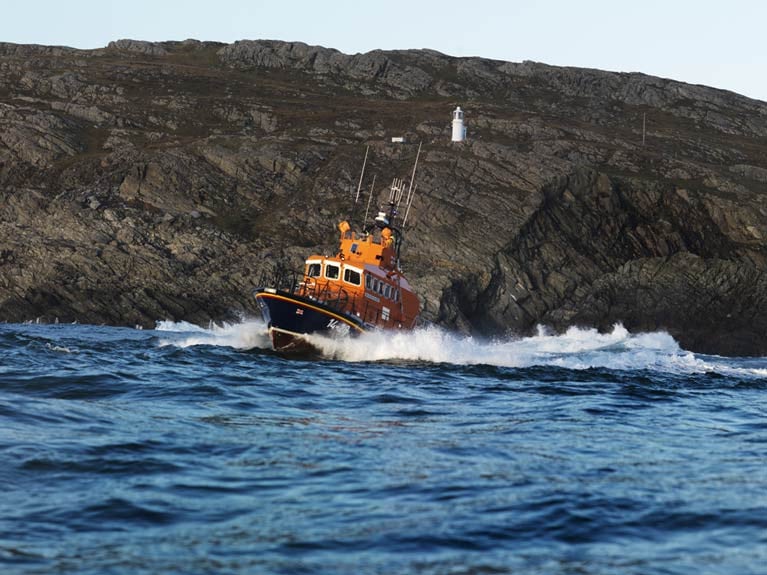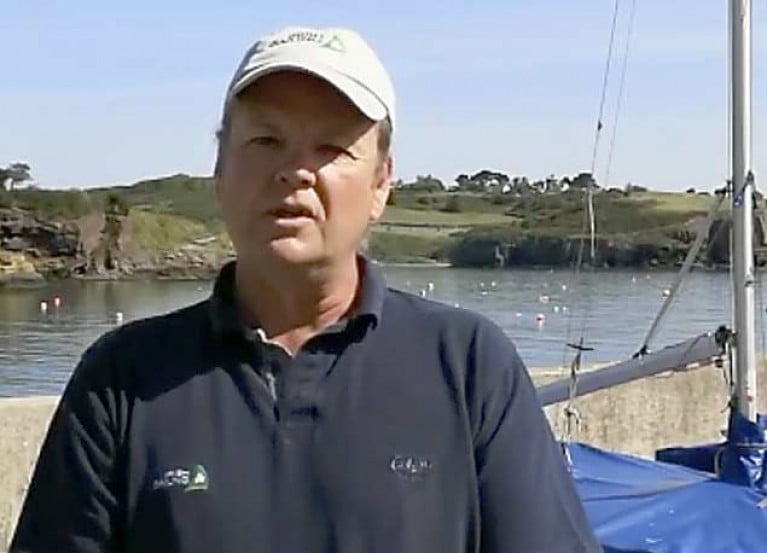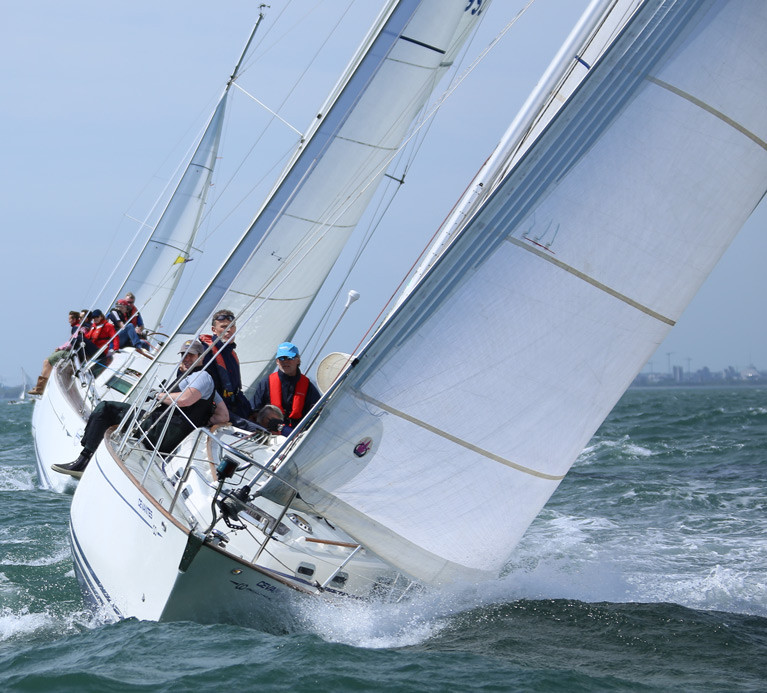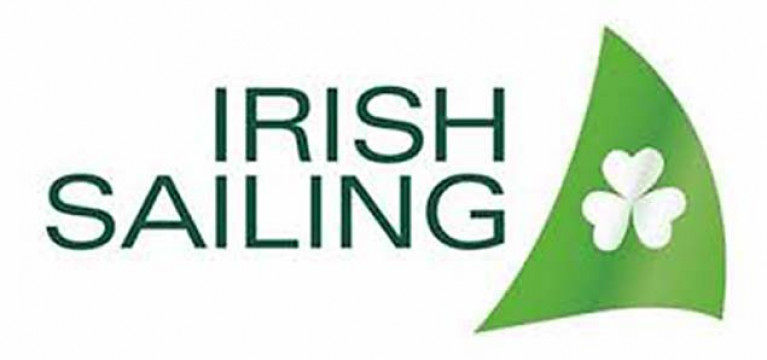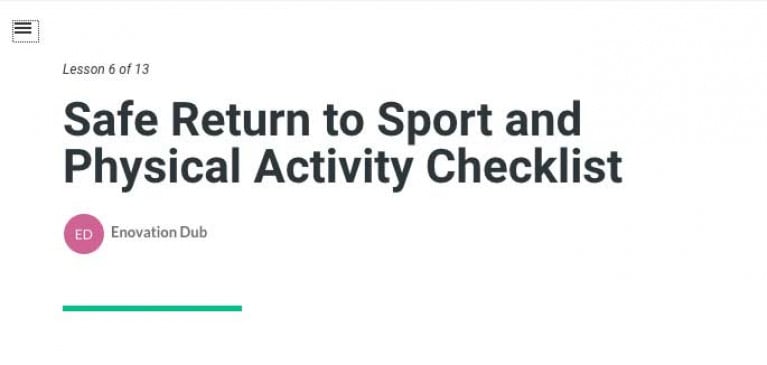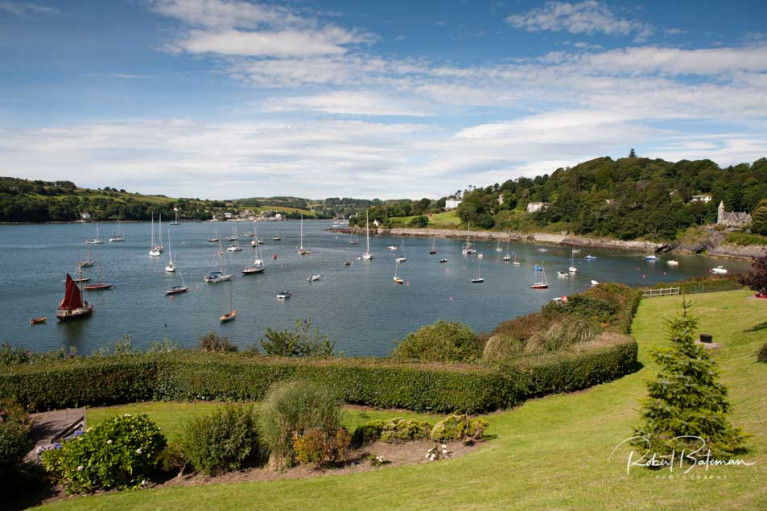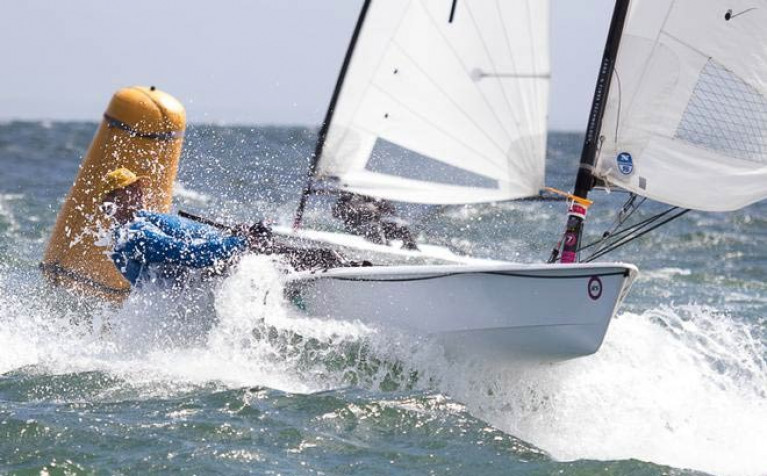Displaying items by tag: Covid 19
RNLI & Irish Water Safety - Living With Covid 19 Guidelines
RNLI stations are reporting a busy season as more people stay at home for holidays due to the Covid-19 restrictions.
As The Irish Examiner reports, new standard operating procedures (SOPs) to adhere with Covid-19 public health and safety guidelines have changed the environment and placed extra pressure on crews.
All around the coast, inshore and all-weather RNLI lifeboats are also being scrubbed with extra vigour – right down to disinfection of handsets on marine radios.
“We had to make a very quick shift, and adopt new standard operating procedures early on,” Courtmacsherry coxswain Sean O’Farrell says.
 RNLI Wicklow mechanic Brendan Copeland
RNLI Wicklow mechanic Brendan Copeland
Crews going to sea with standard RNLI personal protective equipment (PPE) wear surgical masks under helmet visors, along with double sets of gloves.
The new measures extend to alerting crews. Every volunteer who responds to a pager message must stay in their car outside the station, unless and until called.
 RNLI Courtmacsherry, Co Cork, coxswain Sean O'Farrell
RNLI Courtmacsherry, Co Cork, coxswain Sean O'Farrell
 RNLI Dun Laoghaire coxswain Mark McGibney
RNLI Dun Laoghaire coxswain Mark McGibney
“We can’t risk an infection that could affect key staff and volunteers, and close down an entire lifeboat station for two weeks,” O’Farrell adds.
“We’re getting used to it very quickly because we are already a lot busier for this time of year,” his colleague, RNLI Wicklow station mechanic Brendan Copeland says.
Water Safety Ireland chief executive John Leech had warned that as Covid-19 restrictions were lifted and travel plans cancelled, there could be the “greatest number in history” on our waterways. Almost two million people live within five kilometres of the coast.
His deputy, Roger Sweeney, confirms there have already been incidents where people have ignored red flags, hoisted at guarded swimming locations to indicate conditions are too dangerous for swimming.
Read more on The Irish Examiner report here
For everyone who gets on board a yacht to go racing as clubs return to competitive sailing, the core issue of a successful resumption is going to be personal responsibility.
That applies to cruiser/racer skippers and to every member of their crews. It also applies to solo sailors in their racing and will impact on race management teams. In sailing, the mantra ‘we are all in this together’ applies very strongly.
There is another aspect of ‘Responsibility’ as racing returns and clubs open and that is of club members in supporting their clubs. There are clubs around the country whose income has been hit by delayed membership renewals. Members have been waiting to see what level of sailing would be possible.
Now the situation is clearer.
Following extensive discussions, the statutory authorities dealing with COVID 19 have accepted that the sport of sailing has shown a lot of responsibility in seeking a return of the sport. Irish Sailing, clubs, individuals and commentators including myself, pointed to the difficulties on a crewed boat of applying social distance requirements. The easing of restrictions allows resumption of racing.
The Chief Executive of the national sailing authority, Harry Hermon, has stressed that personal responsibility is going to be of major importance in a successful restoration of racing.
Renew club membership
He has also warned that, if members don’t support their clubs by renewing membership, there could be a situation ahead, where some clubs won’t be able to continue. “Your clubs need your support now more than ever,” he said.
What does “pods” mean?
He is my guest on this week’s podcast where we discuss - What does the system of “pods” mean? What are the implications for offshore racing, involving overseas boats? What is the new situation for cruising yachts, motorboating and powerboating?
This week’s Podcast here
"Fear of Law Suits" May Have Influenced Government Decision to Approve Early Reopening of Islands
Outgoing Gaeltacht minister Sean Kyne has expressed disappointment at the Government decision to approve early re-opening of offshore islands to visitors from Monday (June 29).
The Attorney General had advised the Cabinet that there could be legal consequences if it did not abide by the advice of the National Public Health Emergency Team (NPHET), Mr Kyne confirmed.
Offshore communities had been taken by surprise when NPHET announced a week ago that travel to and from islands could resume from June 29th.
The Government’s “road map” had originally set from August 10th as a date for all but essential travel to and from islands.
Mr Kyne said he contacted Taoiseach Leo Varadkar and Cabinet colleagues about the need for a more phased approach, given the lack of time to prepare for anticipated large numbers of domestic visitors.
Mr Kyne confirmed that he had received appeals from Aran island medical professionals urging caution, but had also been contacted by tourism interests seeing an early reopening.
He said that NPHET’s advice to Cabinet was that there was no reason on public health grounds for curtailing visitors to the islands.
“I am disappointed - I expect some businesses will decide against reopening on Monday,” Mr Kyne said.
Two Aran islands – Inis Oírr and Inis Mór – held surveys which voted overwhelmingly against an early reopening.
All three Aran islands are in a declared Irish Water “drought” category, and have had water rationing due to the severe dry spell.
In Inis Oírr’s case, 92 per cent of residents and businesses voted against re-opening for the remainder of the summer due to fears over the spread of Covid-19.
A number of other islands have limited health facilities, lack of provision for public toilets, and limited scope for social distancing on piers during busy ferry berthing periods.
"The Government seemed to be more afraid about protecting itself against law suits by businesses than our public health," one island resident said.
Earlier this week, the Irish Islands Federation, Comhdháil Oileáin na hEireann called on the Government and NPHET to provide “clear guidance and protocols” on the safe re-opening of islands to visitors.
The federation pointed out it had not received any written reply to submissions to State agencies, "seeking direction and supports for the offshore islands".
Government Covid 19 data suggests that up to six electoral districts with islands had less than five cases of the virus, but the Department of Health would not comment further.
Island representatives are only aware of one case on the largest Aran island of Inis Mór and a very small number on Achill island, Co Mayo, which is connected to the mainland by a bridge.
The island federation had no comment to make yesterday.
Following the Commodore’s Conference on Zoom yesterday (Thursday) evening to analyse the lifting of COVID-19 Lockdown restrictions, the basic reality is that club racing is allowed to resume from next Tuesday (June 30th) provided that crews comply with much-relaxed social distancing requirements, while most clubhouses will be open and functional within the same limitations.
It’s a complex situation, and it’s unreasonable to expect a long list of official does and don’ts as sailing and boating try to get back towards some sort of normality. After all, everything to do with boats and their use is supposed to be ultimately about self-reliance afloat, it’s supposed to be what seamanship is all about. So if people lack the savvy to apply common sense to a changing public health situation and how it affects our sport, then perhaps they shouldn’t be going near boats in the first place.
For ours is a robust and healthy sport, with the action taking place in the brisk open air, just as fresh as fresh air can be, while the sailing population, in general, will surely prove to have been significantly less affected by the Coronavirus than the population at large. So maybe it’s time people just got on with it, and stopped waiting for cast-iron official directives before making any move, showing instead an ability and readiness to apply personal responsibility and a capacity for initiative.
 Now, after three and more completely blank months of negativity and bewilderment and severely constrained existence, it’s time for us to get out and about and sailing again Photo: Afloat
Now, after three and more completely blank months of negativity and bewilderment and severely constrained existence, it’s time for us to get out and about and sailing again Photo: Afloat
When sailing fans demanded to know when they could go sailing again as the Coronavirus receded and Lockdown was eased through its various phases, it soon becomes clear that there’s much more to their concept of “going sailing” than simply getting into a boat with one or two others who comply for a bubble or pod within COVID-19 regulations, and then just going for a sail within five kilometres from their home port, and returning to it at the end of a mini-voyage.
Yet anyone prepared to accept that as an interim stage in the process back towards normality could have got sailing of sorts. Not perfect by any means, but sailing nevertheless. And if they felt the need for some competition afloat, they could very quickly have arranged informal matches with just one other boat sailed by friends, through the VHF or over a mobile. And they could then talk of having had a “race” as they returned in a social-distance compliant manner to the marina or mooring.
If people had been prepared to accept that as the beginning of the process, they could have been “going sailing” and having had racing of sorts since May 24th. And certainly, the Sailing Schools who are in it for more than simply enjoyment have been organising sailing of the new type for weeks now.
But in today’s very structured world, it seems that the ordinary punters want much more than just “going sailing” in order to tempt them afloat again. The truth is, they want the full monty, with an intense highly-organised racing programme, and hearty socializing afterwards. And even with cruising folk, the freely sociable element is an important part and often essential of the mix.
Either way, this “all-or-nothing” attitude was becoming much too prevalent. So maybe it’s time we grew up. None of us in Ireland among current generations has ever experienced anything remotely like this Lockdown, with its inevitable implementation of what seemed very like a high-powered version of the Nanny State.
For sure, it was necessary at the time, and the nation is to be commended for generally accepting the onerous restrictions which were imposed. But now we have to accept that the threat is receding, and it’s time to become responsible adults again. For, after three months of Lockdown, there are signs of creeping infantilism throughout society, and an expectation of complying with detailed directives at every stage.
That isn’t the way life should be in the real Ireland. We should be showing more spirit. And while it’s clear that the official and governmental authorities are risk-averse as public and semi-public authorities are programmed to be, the yacht and sailing club Commodores are showing a spirit of adventure and entrepreneurship. For in effect, they represent the vital and key private enterprise sector of our sport, and they have to get their clubs back to a level of economically-viable activity just as soon as is humanly possible.
Thus there never has been a time when the yacht and sailing clubs of Ireland have more urgently needed the full, enthusiastic and understanding support and involvement of their members. And there has never been a time when it is essential for everyone to resume sailing – albeit within limits which may in some cases seem niggling – just as soon as possible.
Several clubs are showing commendable initiative in offering significant discounts and the opportunity for late entries in order to get the complicated yet truly remarkable Irish sailing infrastructure back up and running again. The least that the sailing community can do is be supportive in backing their efforts. Sailing is ultimately a complete community activity, and as with all community activities, in the last analysis, you only get as much out of your club and your sailing as you are prepared to put into it.
 Sailing is ultimately a complete community activity Photo: Afloat
Sailing is ultimately a complete community activity Photo: Afloat
Now, after three and more completely blank months of negativity and bewilderment and severely constrained existence, it’s time for us to get out and about and sailing again. And okay, maybe, for now, it’s not truly sailing as we know and love it in all its full sporting and socially-carefree complexity. But what’s now becoming possible is a massive step in the right direction, and every journey starts with one step.
Each club is providing clearcut guidance towards taking that step in accordance with the special setup and circumstances which obtain at each club. And as I happen to sail from Howth, which has been in the forefront of the process of getting sailing going again, it’s timely to conclude with the letter to members issued by Commodore Ian Byrne this (Thursday) evening:

Dear Member,
Many of us have enjoyed the recent spell of good weather pottering responsibly in our wonderful sailing area. The Irish Sailing Return to Sailing Phase 3 plan brings us closer to a new normal, and their meeting today gave us guidance on getting back to racing.
Club racing can start from next Tuesday with full crews. In line with the Government strategy the guidelines are relaxed and emphasis has shifted to prioritising contact tracing with a recognition that, where physical distancing cannot be reasonably achieved in a sport, each individual must assess the risks and minimise them whilst trying to follow hygiene, etiquette and distance recommendations. The term ‘pod’ is used to describe a virtual household that is a crew, race committee, safety RIB etc. with each individual pod remaining socially distant from others on the water and ashore.
This also has positive implications for Junior courses and safety boat crews which the Sailing Committee will work on in the coming days.
You will already have received an email announcing that club racing fees are waived for 2020. Online entry is now available on hyc.ie. The Fingal League starts on Sat 4th July and our clubhouse will open next Monday with a special menu and our usual array of beverages served by Frank and the team inside or on the balcony in our comfortable, spacious and safe surroundings.
There is plenty of summer left to enjoy your sport through July and August. A perfect lead into Wave, Ireland’s best Regatta this year, on 11th Sep followed by the Autumn League on 19th Sep to 24th Oct. Almost 4 months of top class racing! There are a few good days to get the boat ready for next week so enter online and get racing.
Your class captain will have more details related to your class after the Sailing Committee meeting tonight including keelboat skipper responsibility to email crew and any changes details in advance each race day.
Ian Byrne
Commodore
Further Lifting of COVID Restrictions from 29th June
This evening An Taoiseach announced plans to “accelerate the reopening of our society and economy with most things in roadmap now being moved to Phase 3 on 29 June”.
Although the statement included a commitment for all sporting activities including full contact sports be allowed to resume, there is currently very little detail communicated or published, and we still have no clarity on how this impacts Irish Sailing’s ‘Return to Sailing Scheme’ for Phase 3.
We anticipate we will be in a position to publish our Phase 3 plan early next week, subject to receipt of clarity around the Taoiseach’s announcement - Harry Hermon, CEO
As Ireland moves through the various phases of the Government Roadmap, Sport Ireland is providing training & support resources to the sector in relation to Covid19.
A Sport Ireland COVID-19 Awareness eLearning Course is now available on Sport Ireland's website through the following link here
While not specific to sailing and boating clubs, the free course aims at supporting clubs, classes, training centres, volunteers, coaches, instructors and participants to return to sport during phase 2 in a safe & practical manner.
Covid 19 Awareness Course Content
- Hand Hygiene
- Equipment Hygiene
- Managing Participants with Covid19 Symptoms
- Return to Sport Planning
- Advice for Group Activity
- Covid 19 Officers
- Recording Attendance & Contact Tracing
- Phase 2 Guidance
- Returning to activity in the Great Outdoors
- Knowledge Check & Quiz
- Staying Informed
Glandore Harbour Yacht Club in West Cork draws its membership from a wide catchment area. It is surveying the members to get their views on how the club’s sailing season can deal with the current restrictions imposed by government under COVID-19 requirements.
After nine months of preparation, the club had to decide late last week to cancel their biennial Classic Boats Regatta which has become a national and international attraction. It drew large crowds to the village, both sailors and tourists, to see the event and was a big economic boost to the area.
‘Social distancing’ requirements had a large effect on the decision to cancel the regatta in July, which would have dovetailed with the Royal Cork Yacht Club’s Tricentenary Celebrations.
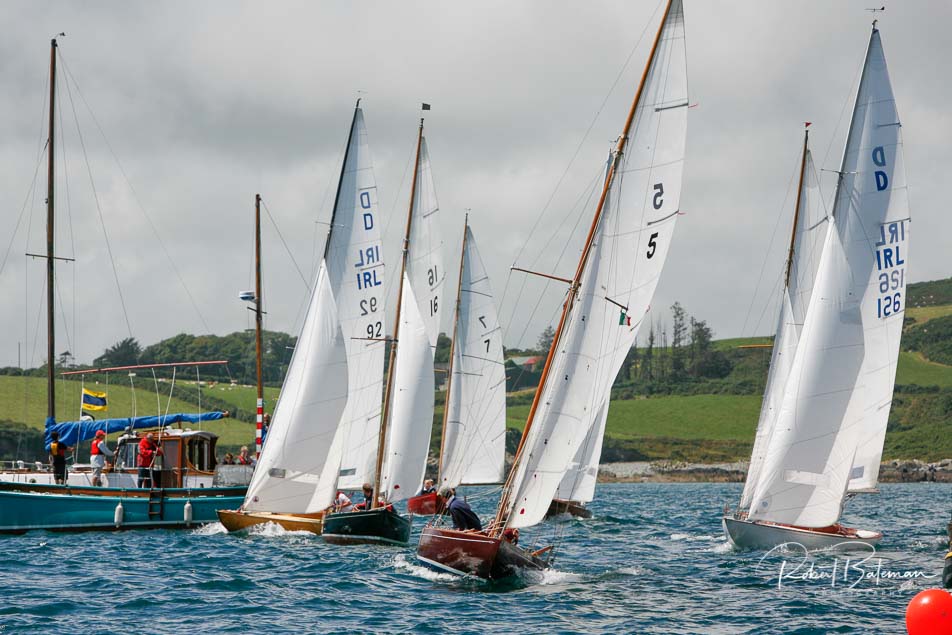 Racing at a previous edition of Glandore Classics Regatta Photo: Bob Bateman. Scroll down for a gallery of photos below
Racing at a previous edition of Glandore Classics Regatta Photo: Bob Bateman. Scroll down for a gallery of photos below
The situation which the club faces is explained in this week’s Podcast by its Sailing Secretary, Hal Andrews, who says that it is “really a nightmare to organise sailing” under the social distancing requirements.
"Social distancing’ requirements had a large effect on the decision to cancel the regatta"
That is becoming evident at many clubs around the country. Irish Sailing is in discussion with Sport Ireland about the difficulties presented to the sport by the restrictions.
Podcast with Hal Andrews of Glandore YC below and a gallery of photos by Bob Bateman of the 2007 Glandore Classic Regatta brings back memories of the beauty of vintage sailing boats in West Cork.

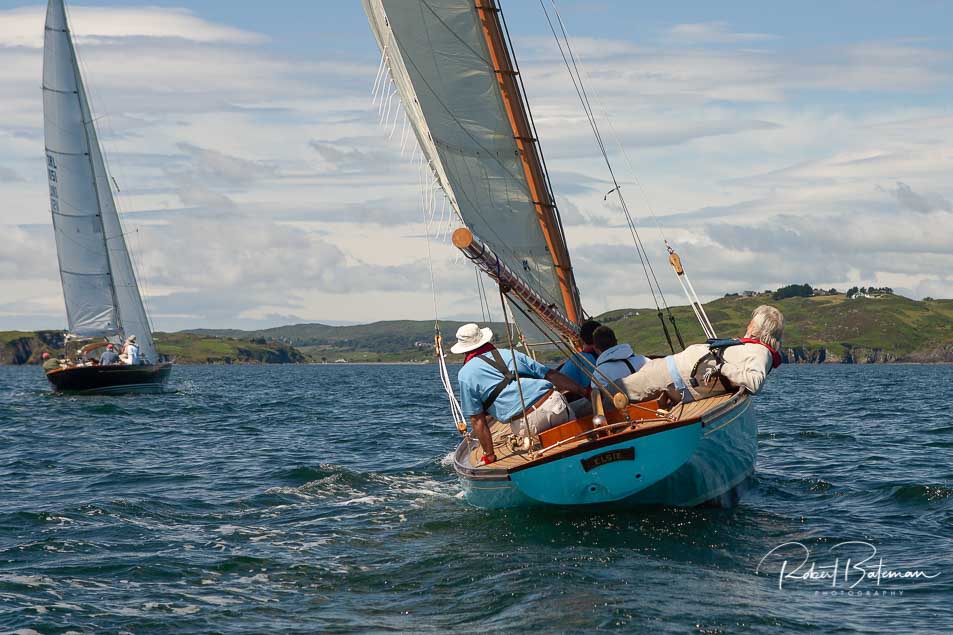
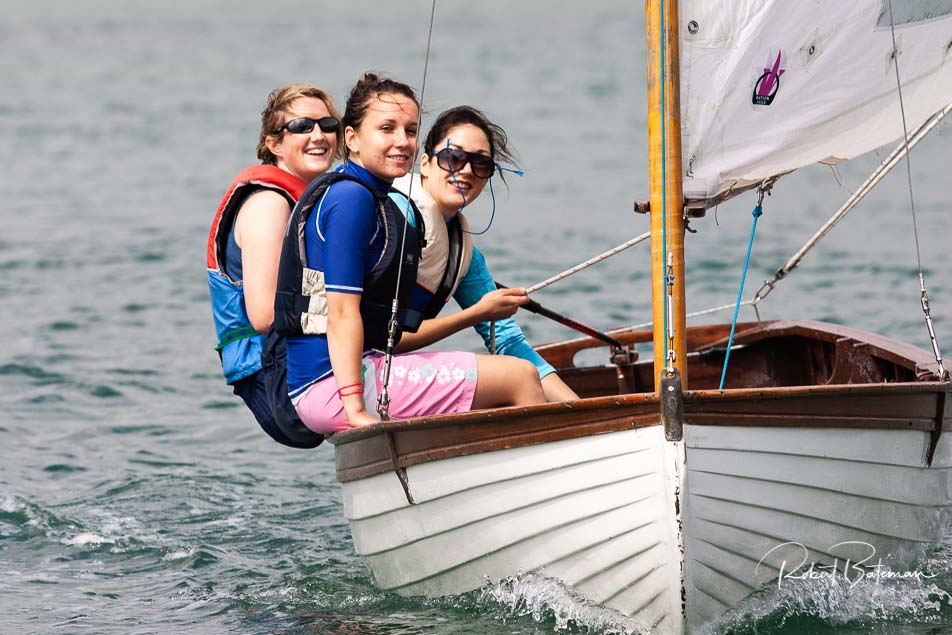

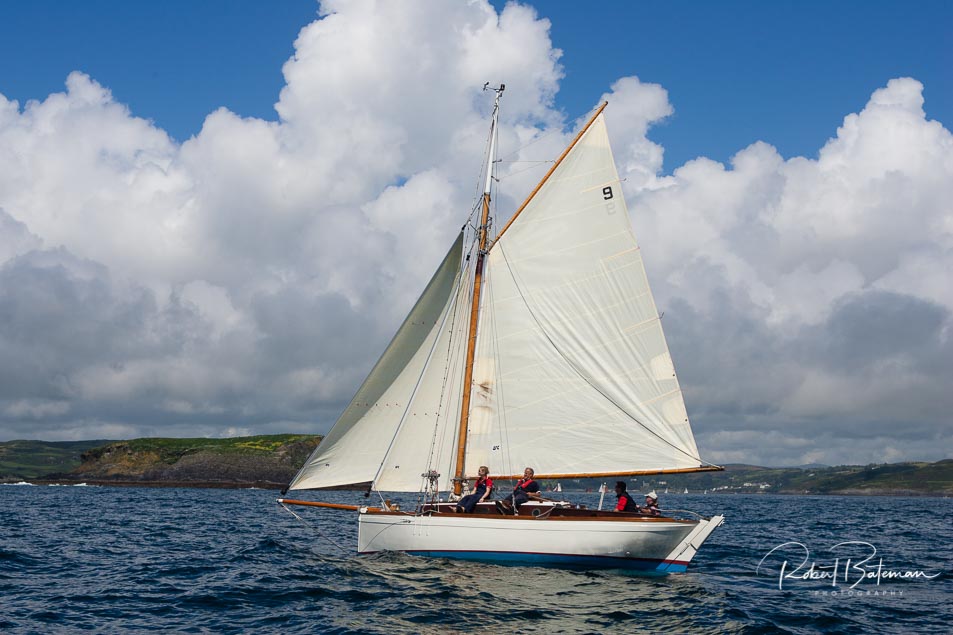
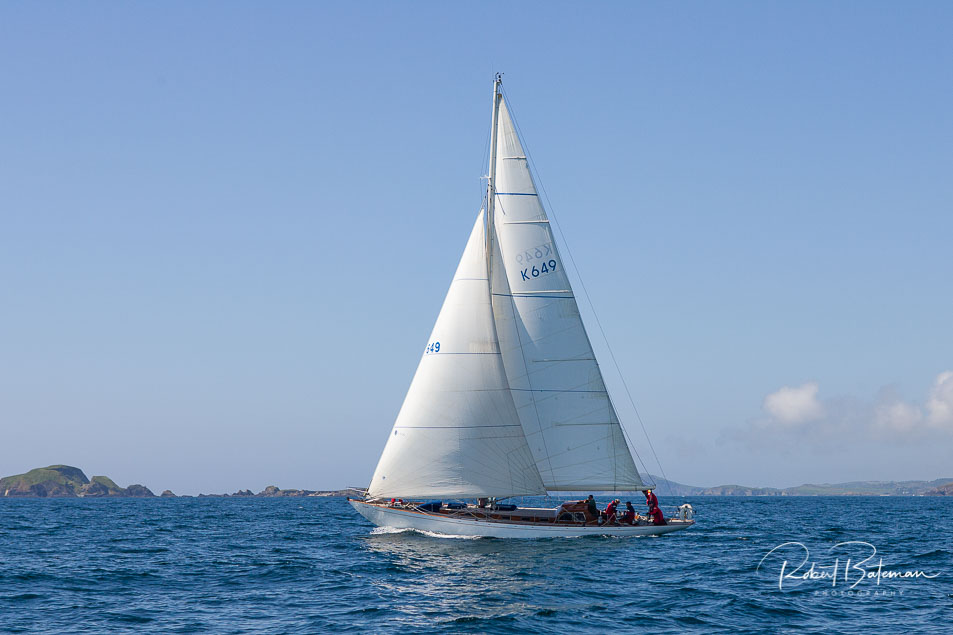
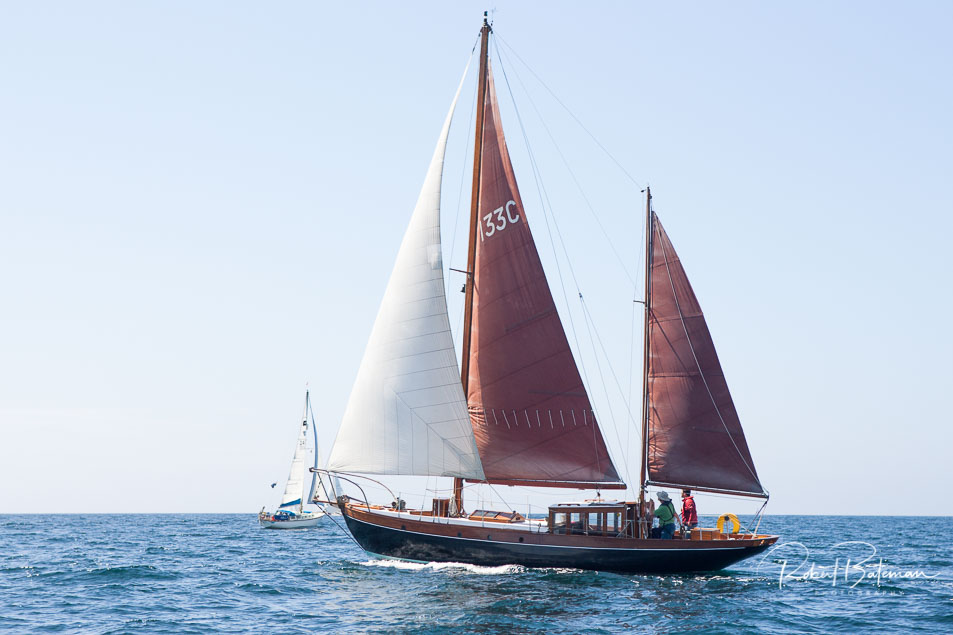
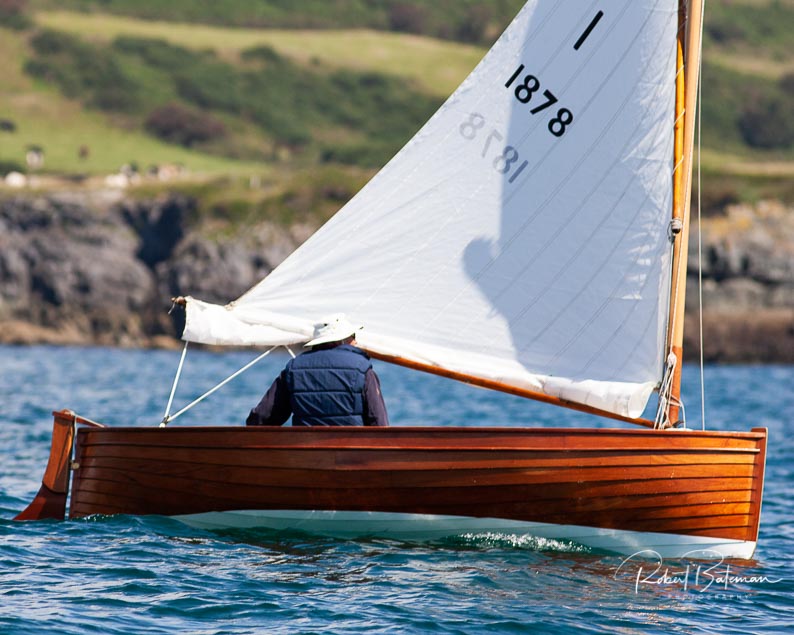
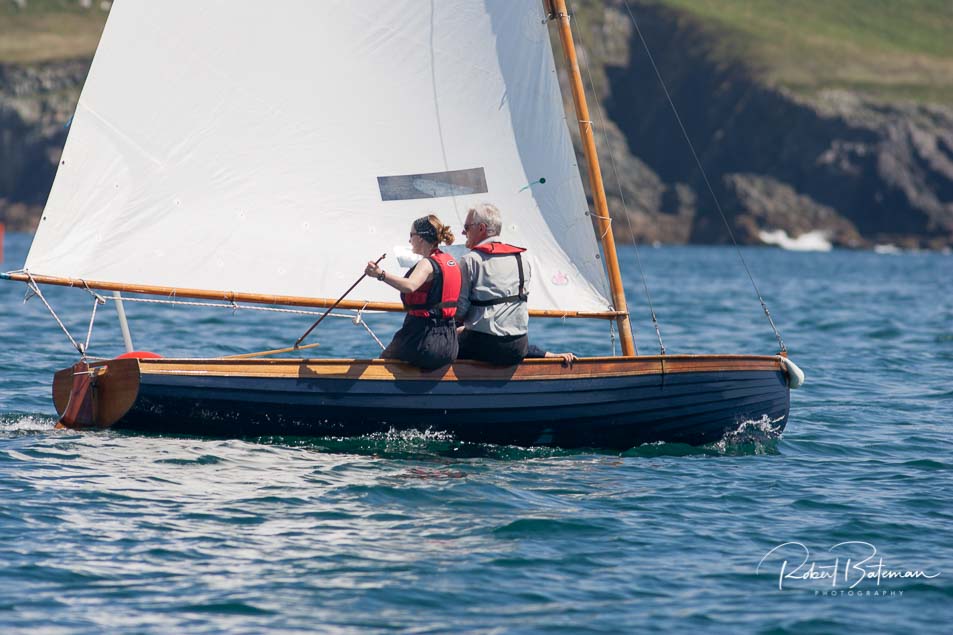
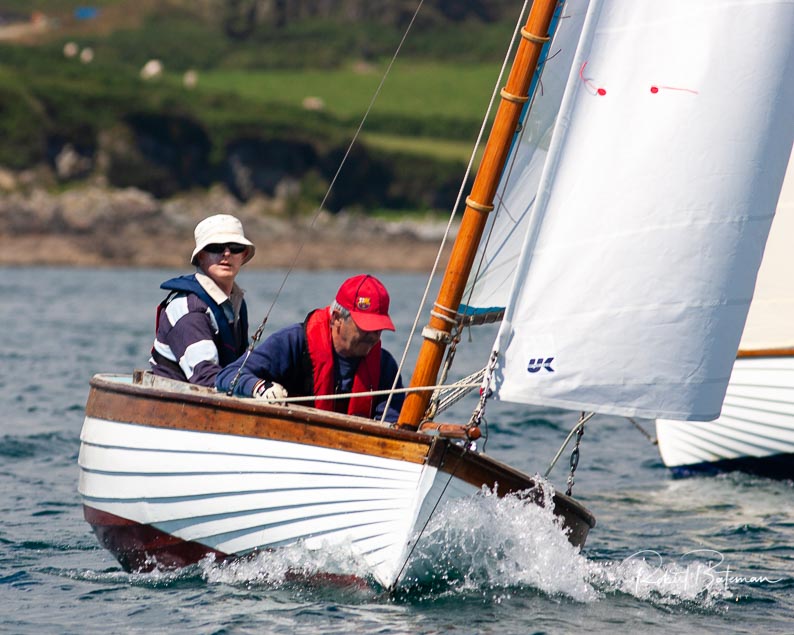

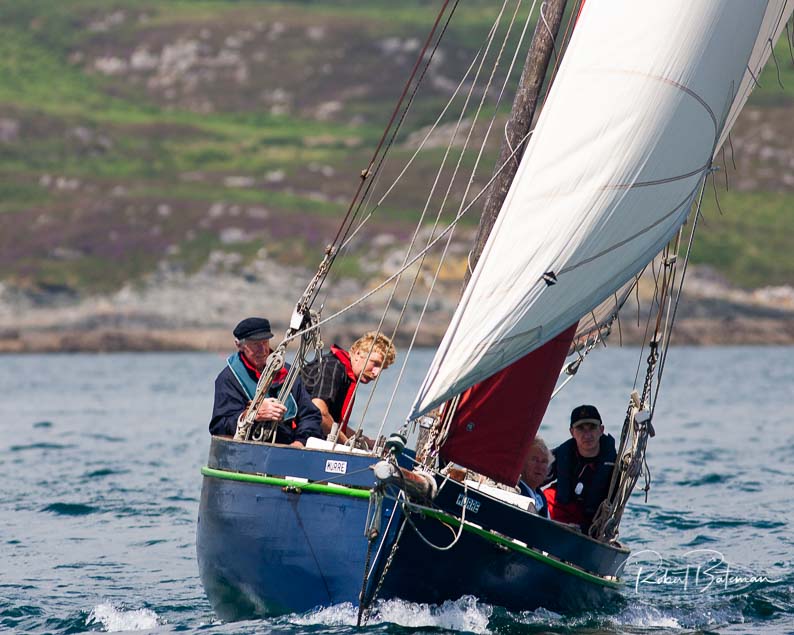
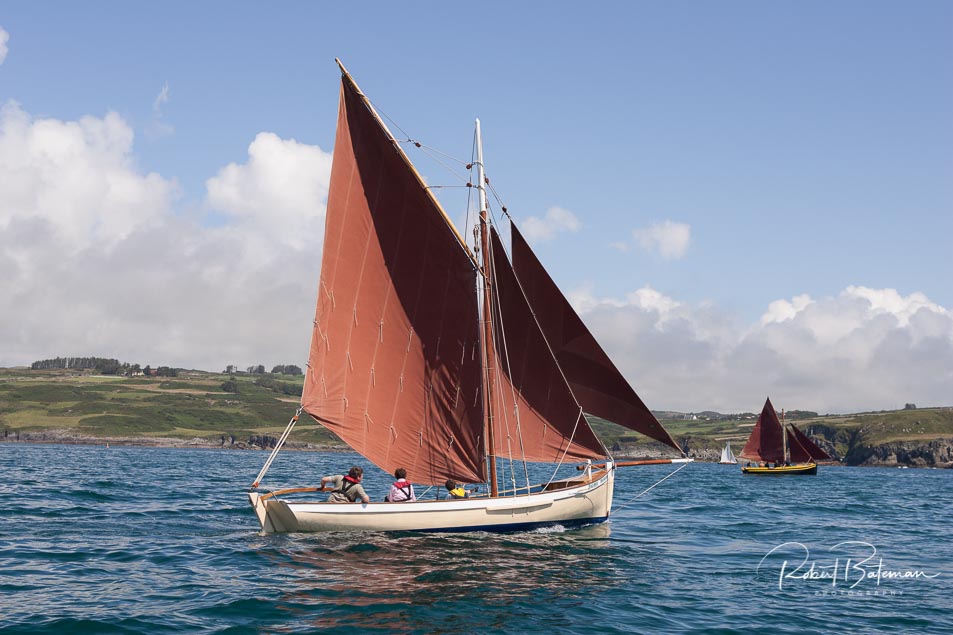
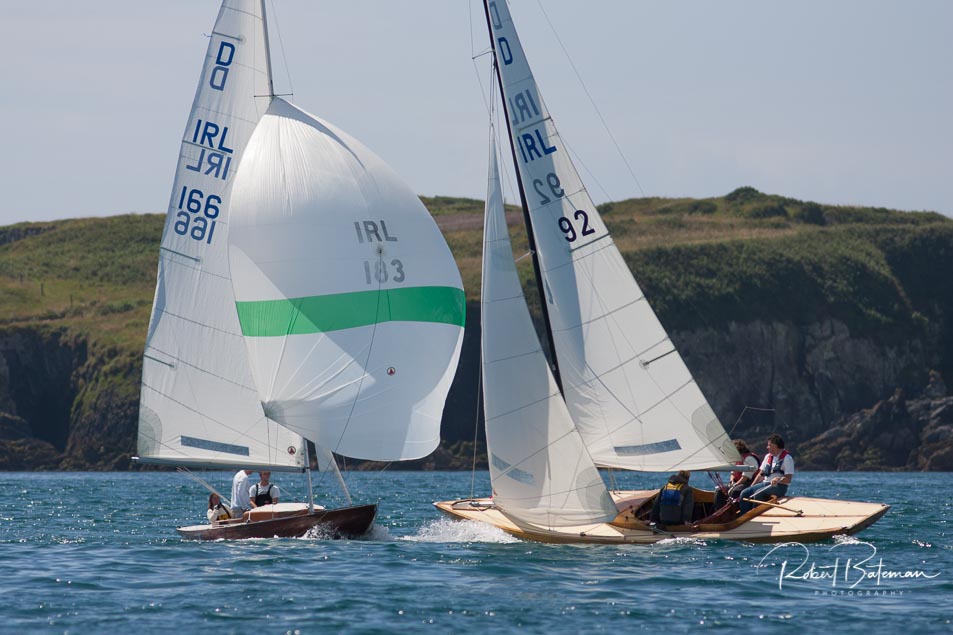

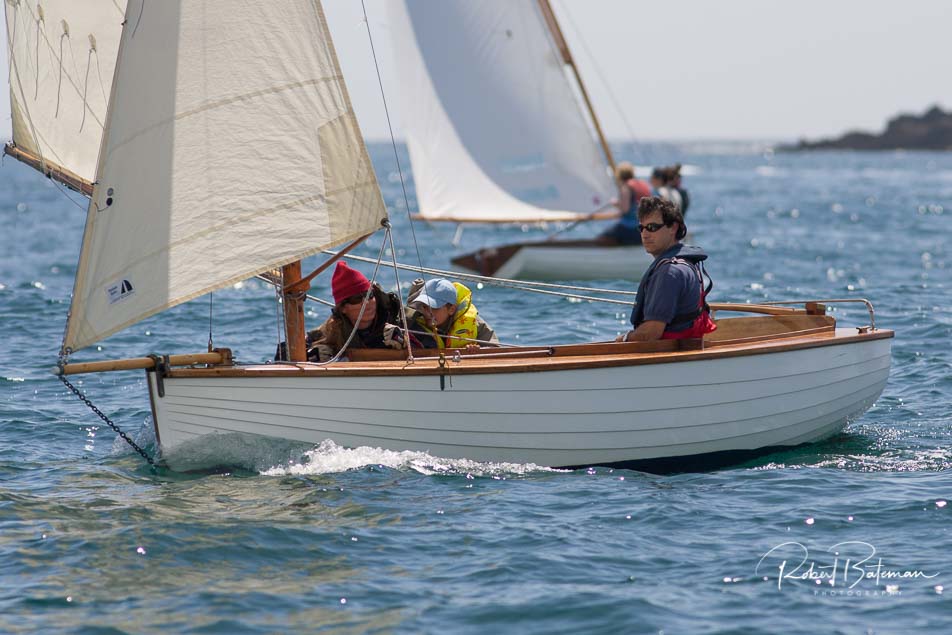
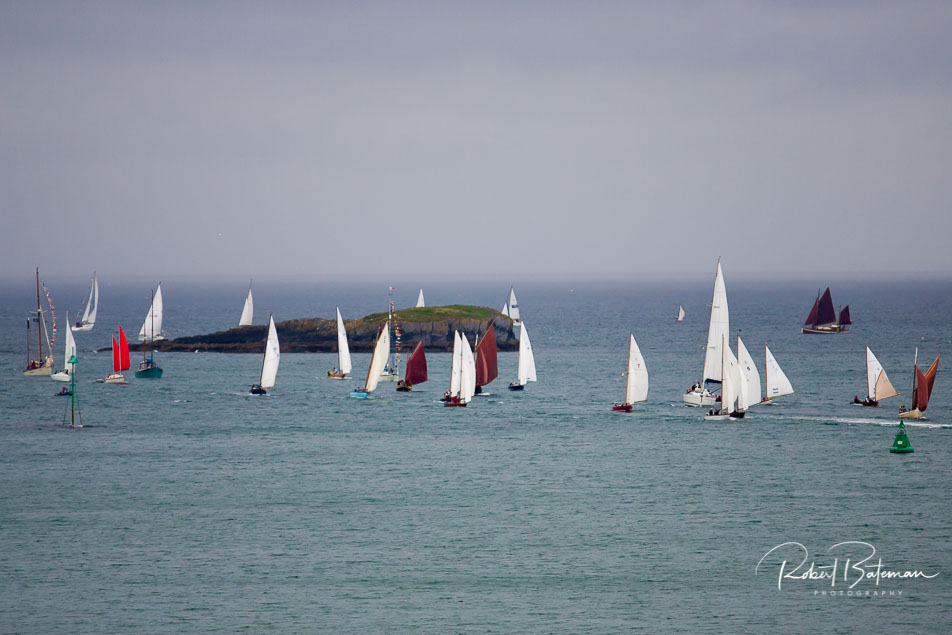
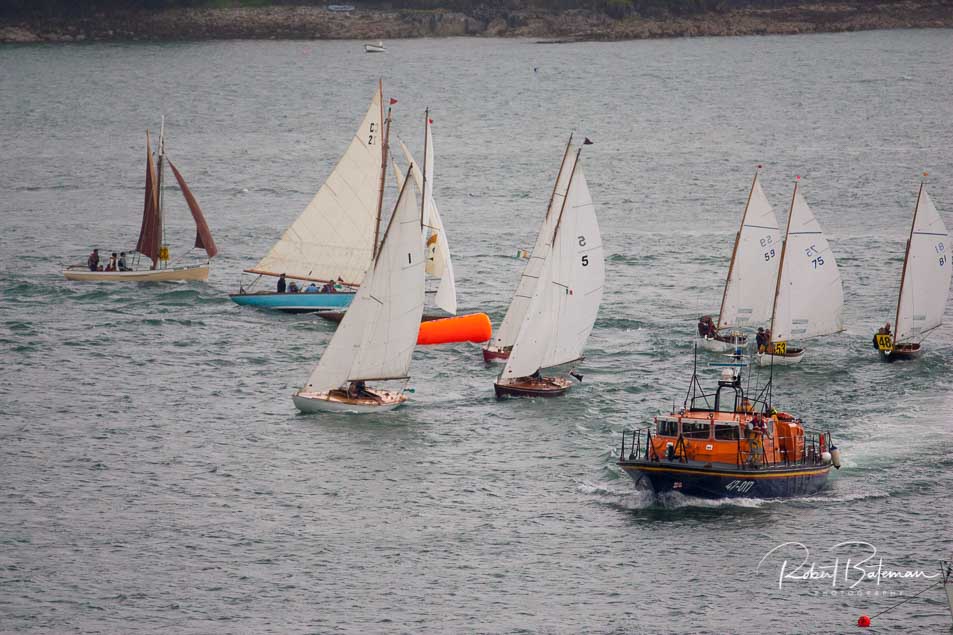
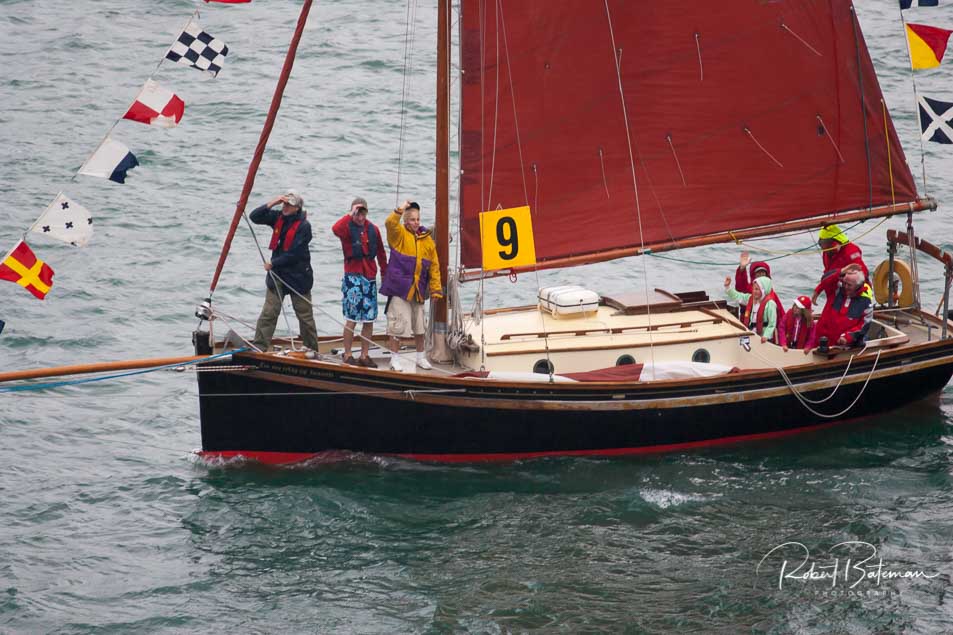
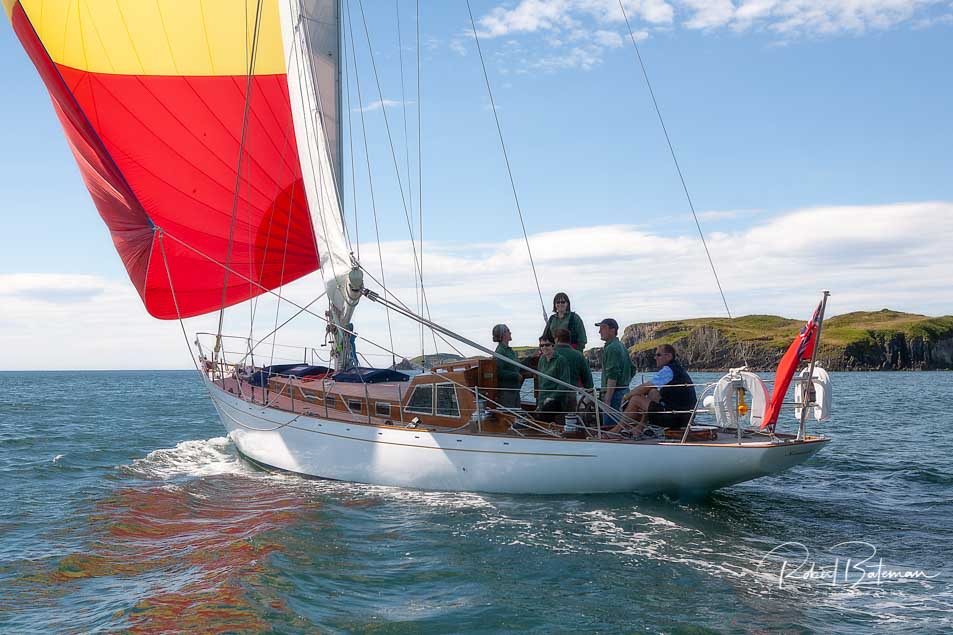
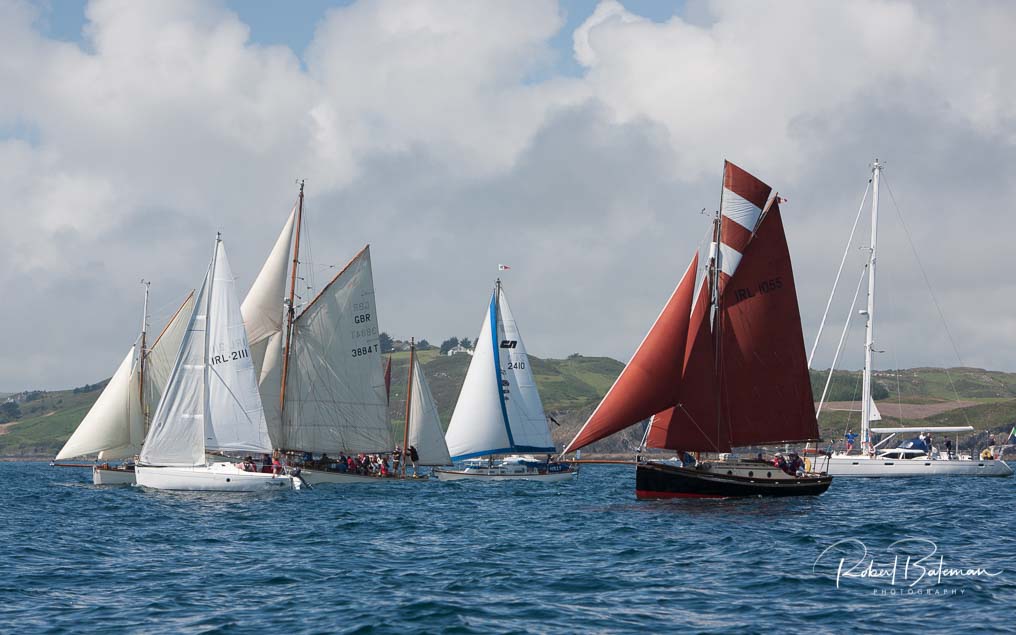





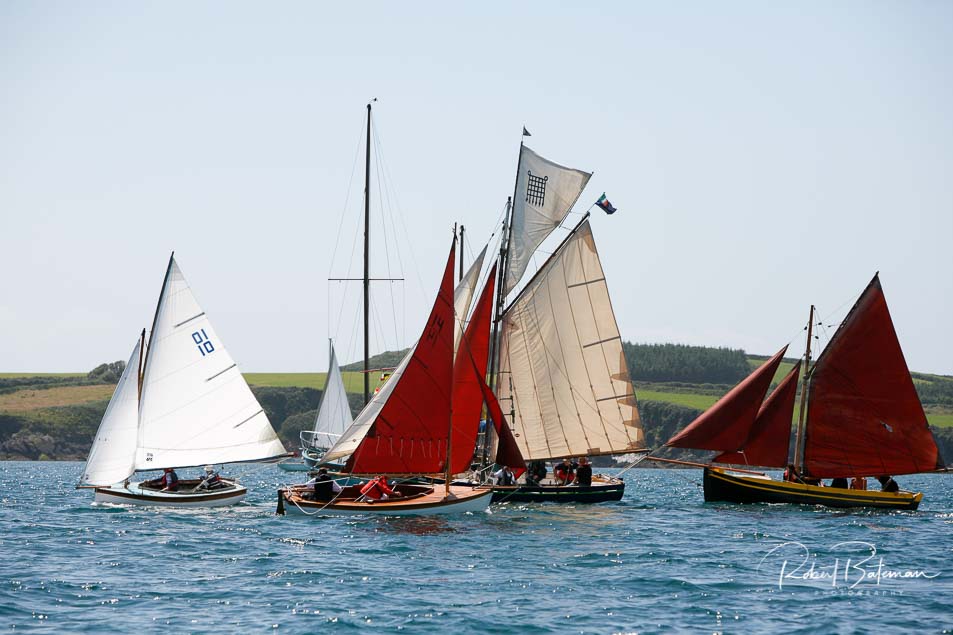
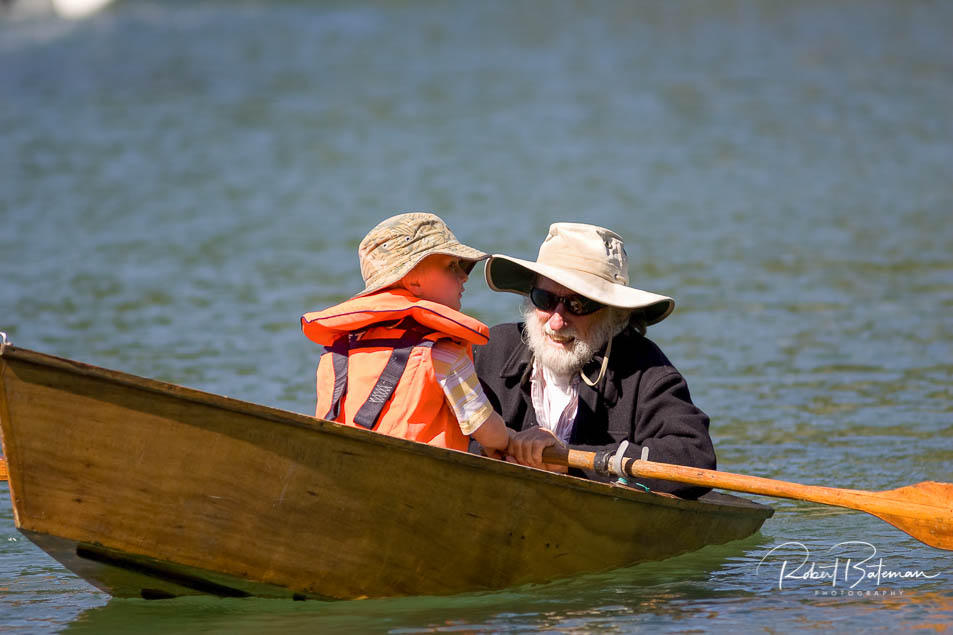

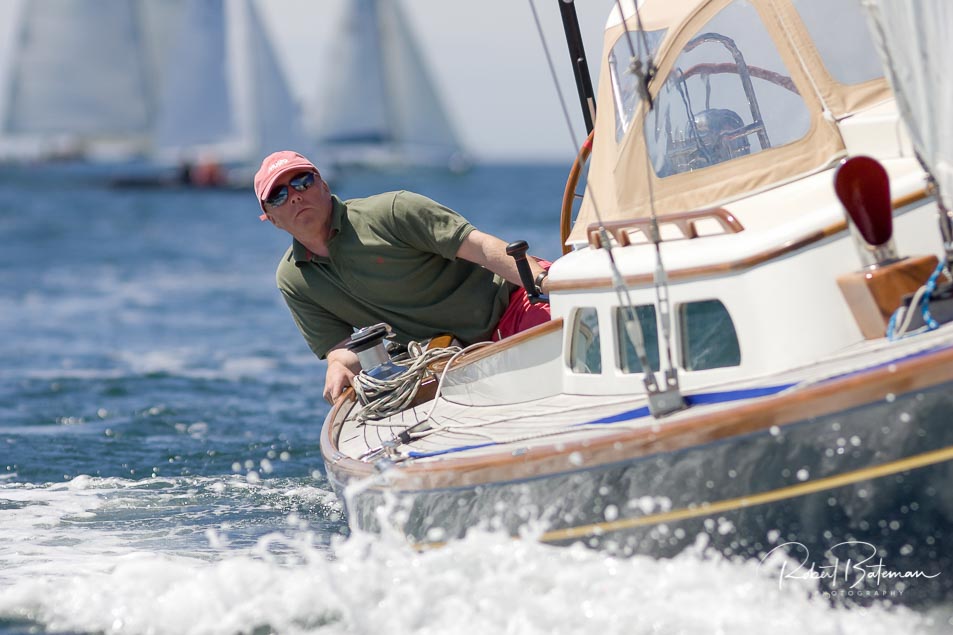
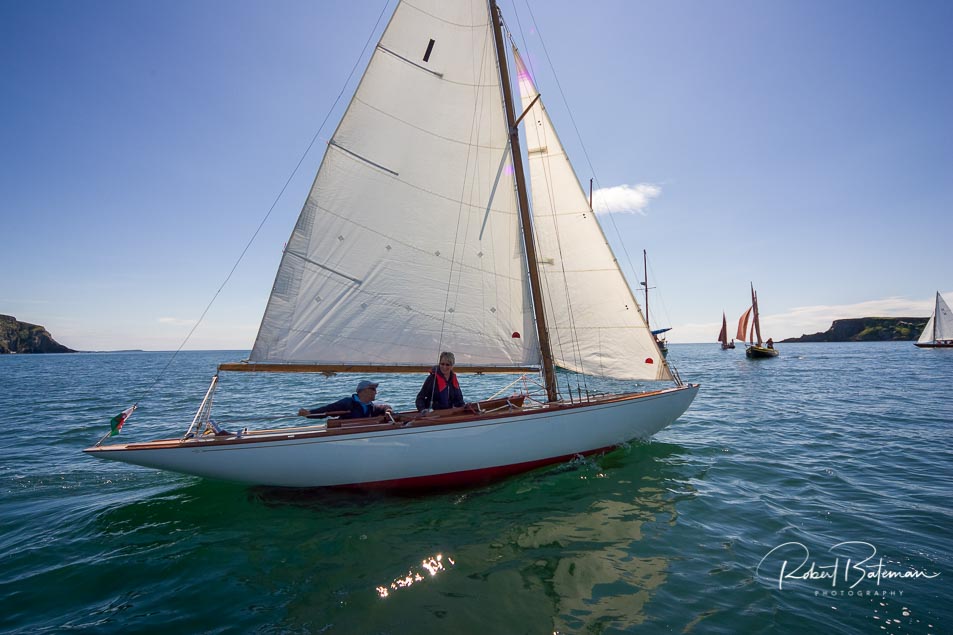
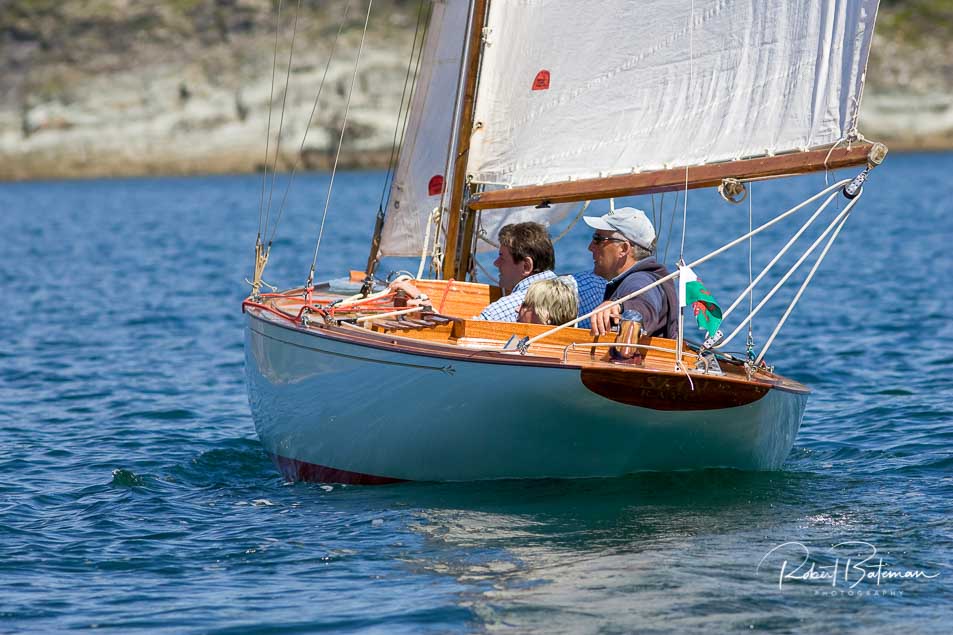
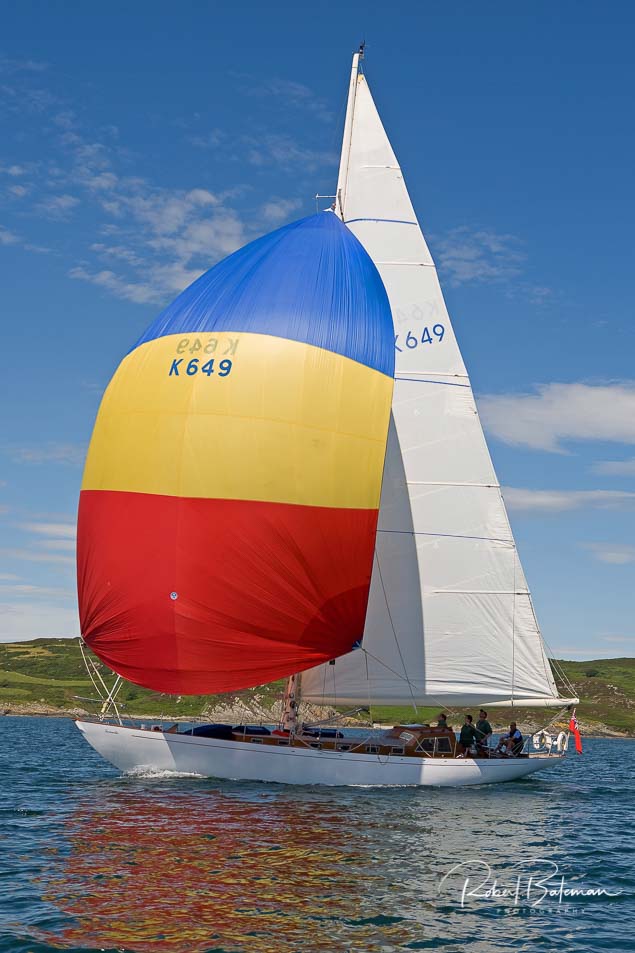
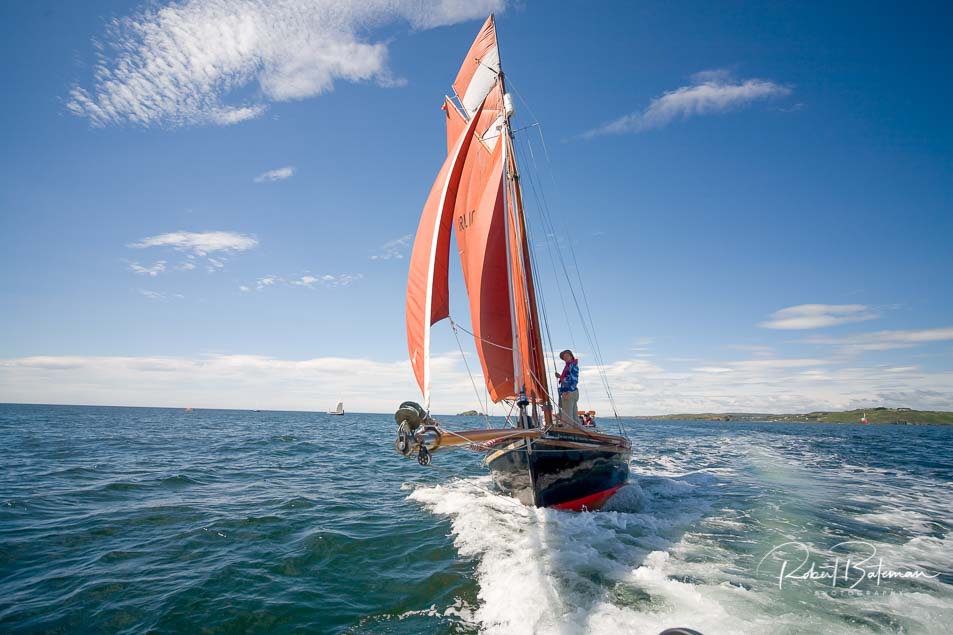
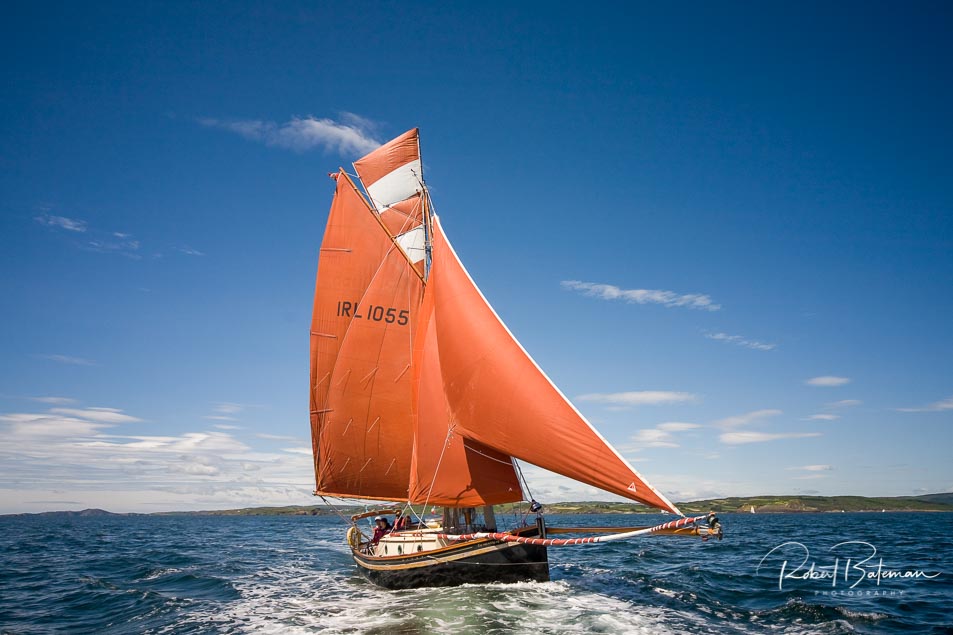

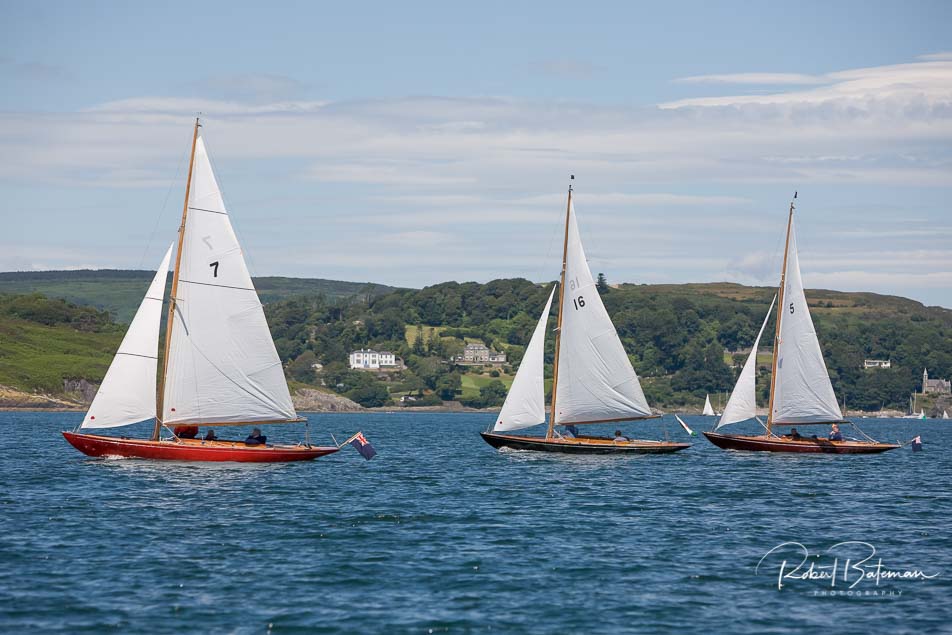
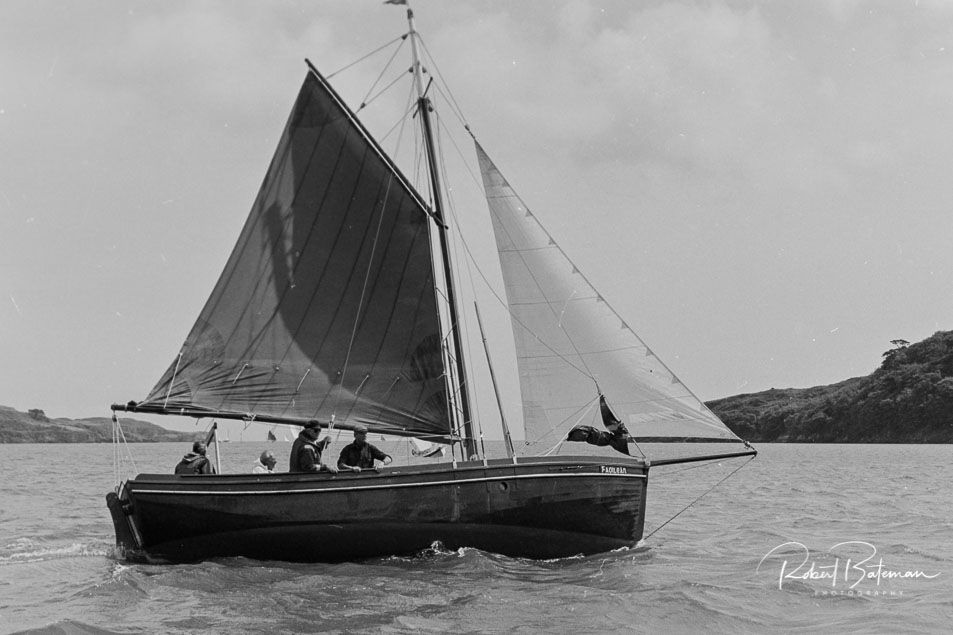
You would expect the sailing community to be more understanding than most others of the difficulties inherent in setting out any sort of comprehensible and feasible plan for the resumption of life in all its forms as the Covid-19 pandemic recedes, for our sport is an activity of many unpredictables. There may have been large pandemics before. But they didn’t occur in a significant form in such a complex and acceleratingly busy a world as we’ve been living in since the turn of the century.
Thus you can certainly make plans and keep making plans, but it would be foolish to expect anything resembling a Fixed Plan, all-encompassing and set in stone.
In sailing a race, for instance, the variables of wind strength and direction, sea state, tidal conditions, and configuration of the fleet are changing in an infinite and endless continuum. Rigid plans are a delusion. We may not all be like ace helm Gordon Maguire, who is so aware of the relative wind changes that he can anticipate them in advance by some time, and sense them in real terms something like a fifth of a second ahead of getting the information from the electronics, all of which can add up to quite an advantage in a complex race. But even the most basic sailor knows that everything turns out at least slightly different from expectation, and we go forth in the fond belief that it might even be better than hoped.
 Gordon Maguire (yellow jacket) helming Ichi Ban to Rolex Sydney-Hobart Race victory. It is his enhanced ability to anticipate and utilise the continuous change in the sailing environment which has made him Australia’s most successful offshore racing skipper
Gordon Maguire (yellow jacket) helming Ichi Ban to Rolex Sydney-Hobart Race victory. It is his enhanced ability to anticipate and utilise the continuous change in the sailing environment which has made him Australia’s most successful offshore racing skipper
Equally, in cruising, the overall Cruise Plan can be a burden which is sometimes best abandoned - or at least put into storage - at an early stage. But with a flexibility of approach, your may eventually find alternative and more enjoyable ways of getting to your original cruise objective, and there are few summers with weather so bad that even the most adroit cruise management cannot provide something satisfactory to reflect on at season’s end.
So in contemplating the “return to normality” plans being put forth by the five different governmental administrations in what the late Gerald FitzGibbon (Eternal Honorary Secretary of the Howth 17 Class) used to describe as the Anglo-Celtic Archipelago, we see differences in approach sometimes so marked that we can only wonder if they are all dealing with the same basic problem.
The Government in London may set out a general plan for England, but it is immediately sniped at for its absence of savvy about how the average household functions, with the point being made that their current Cabinet includes exceptionally few women, even though Margaret Thatcher as Prime Minister once said that any woman who could competently run a household can make a fair fist of running a country.
 British Prime Minister Margaret Thatcher – she reckoned that the competent running of a household was excellent training for running a country.
British Prime Minister Margaret Thatcher – she reckoned that the competent running of a household was excellent training for running a country.
With this broad plan complete with too many specifics and hints at actual dates being run out and then changed next day, the various sailing and boating bodies have been making the best of it for their own areas of interest. Thus we find intriguing snippets such as the fact that family groups may do a spot of boating on their local waterways and canals provided they avoid using locks, where safe social distancing would be very difficult. But you wouldn’t get very far on most English canals without transiting a lock. In crowded England, these are highly sociable places, where the habit of lounging ashore and interacting with the boat crews going through is so prevalent that those who do it regularly are known among the boat people as “gangoozlers”. They’re a species unknown along the Shannon, our mighty waterway which is mercifully restricted to just seven locks, and has thousands of acres of clear uncrowded water.
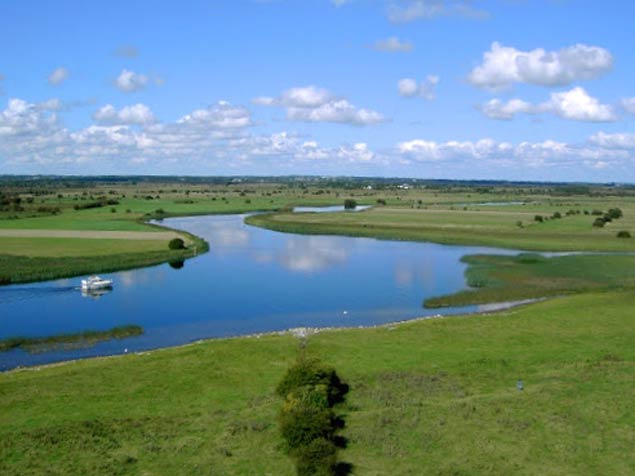 The lordly River Shannon provides much better opportunities for social distancing than the typical English canal.
The lordly River Shannon provides much better opportunities for social distancing than the typical English canal.
For the unfortunate Welsh with their long border with England, yet with a higher proportion of at-risk people in their population, the extension of the Lockdown is insisted. But whether the Welsh can stop the English pouring over the border this weekend is a moot point. Even at the height of the Lockdown, a policeman in Llandudno in North Wales flagged down a be-leathered man on a large shiny motorbike, to be told that he was just out running an urgent errand. The errand was apparently to buy sausages. His point of departure? Nottingham.
 In the Lockdown period in England, this has proved to be the ideal machine for nipping down to the shops for a packet of sausages
In the Lockdown period in England, this has proved to be the ideal machine for nipping down to the shops for a packet of sausages
Inevitably, away to the north, the instinctive hostility between the English and the Scots has been regularly re-surfacing. It’s only a matter of time – if it hasn’t been done already - before someone quotes the quintessential English writer PG Wodehouse’s comment: “It is never difficult to distinguish between a Scotsman with a grievance and a ray of sunshine”.
Meanwhile the rather wishy-washy slogan “Stay Alert” has become national policy. At least they’d the sense to use this version. There are those among us who can remember some other crisis when the official exhortation was “Be Alert”. This didn’t last long, as the local Voluntary Thought Police were soon adding “The World Needs More Lerts” underneath.
Whatever, already we are in the blame game, and on that count, we should remember the wickedly effective re-working of the pious thoughts of the famous American sports-writer Grantland Rice (1880-1954):
“And when the One Great Scorer comes,
To write against your name,
He marks not that you won or lost,
But how you spread the blame”
That will be the theme in London and elsewhere for quite some time, and in contemplating the happenings on that larger island next door, some of us might incline to the scary thought that we are seeing the Romans becoming Italians, with the Dark Ages imminent, and with the occasional complete pessimist perhaps even wishing that St George’s Channel were at least twice as wide.
 Social distancing, Cheltenham style. Even in imminent pandemic times, no patriotic Irish race enthusiast could be anywhere else.
Social distancing, Cheltenham style. Even in imminent pandemic times, no patriotic Irish race enthusiast could be anywhere else.
As it is, in retrospect there are two people across the water that we can blame for some of the Covid-19 in Ireland. One is whoever decided that the Cheltenham National Hunt Festival should go ahead, where the hazards were immediately obvious once it was under way. And the other is Jurgen Klopp. For had not Herr Klopp brought Liverpool Football Club to such a peak of excellence, their many Irish supporters would not have been obliged to mix at a crucial time in pandemic development with vast numbers of infective Spanish and Italian fans at the international championship fixtures that his inspired team management had made possible.
 Jurgen Klopp’s huge success in managing Liverpool FC may have contributed to Ireland’s experience of Covid-19
Jurgen Klopp’s huge success in managing Liverpool FC may have contributed to Ireland’s experience of Covid-19
Even with St George’s Channel at only fifty nautical miles wide, and the North Channel even narrower, there still seems to be a really useful saltwater cordon sanitaire between Ireland and chaos, and while there has been the occasional squabble, the level of social cohesion and adherence to the rules of Lockdown in Ireland have been encouragingly high. But such a balancing act can be maintained for only so long, and people are climbing the walls in their hopes of getting back to some form of sailing, or afloat in some way.
Thus this week here in Howth we’d a keen sea angler who thought he might get away with a couple of hours of his beloved sport if he launched his little outboard boat from an almost-forgotten ramp hidden away outside the back of the harbour. For although sailing is a complete no-no under total lockdown, as even the smallest sailing boat sticks out like a sore thumb, any little powered boat suddenly appearing past the harbour mouth is assumed by casual observers to be a local lobsterman going legitimately about his business, the launching and so forth having been well hidden from the real lobstersmen within the harbour.
 Howth Harbour from the north. A little-known launching ramp to the west of the harbour was utilized by a desperate sea angler to launch his boat in secret, but an engine break-down blew his cover.
Howth Harbour from the north. A little-known launching ramp to the west of the harbour was utilized by a desperate sea angler to launch his boat in secret, but an engine break-down blew his cover.
But God is not mocked, as our Cunning Cod Catcher discovered. His engine wouldn’t re-start when his fun was finished. So the Howth Inshore Lifeboat had to bring him in. But as there are so few clearly established laws and rules about how to act in this current exceptional situation, with no statutory body with any muscle to take responsibility and prosecute in some way, the Flexible Fisherman simply stayed absolutely schtum, didn’t say a single word to anyone, and it all just petered out when everyone had to go home for their tea.
But after Monday (May 18th) we’re told that easing is going to begin, and soon those golfers who have been managing to slip under the radar (for we’ve ten golf courses more or less within five kilometres of here) will now be legitimate provided they’re maintaining Social Distance.
That noted mover and shaker in sailing progress, Peter Ryan the Chairman of the Irish Sea Offshore Racing Association, reckons the Social Distance two metre requirement is the stumbling block, and while Mark Mansfield of Cork has been thinking long and seriously about how to resume keelboat racing while complying with pillars of the current policy, Peter Ryan reckons the authorities are going to have to re-think on this one, particularly if valid testing methods can be securely in place.
 Sociable times. Peter Ryan of ISORA (right) at the launching of a Race Sponsorship with John Rutter and Michael Martyn of Kona. But in the current difficult times, Ryan is looking at ways in which such socialising can be minimized in order to allow offshore racing to take place.
Sociable times. Peter Ryan of ISORA (right) at the launching of a Race Sponsorship with John Rutter and Michael Martyn of Kona. But in the current difficult times, Ryan is looking at ways in which such socialising can be minimized in order to allow offshore racing to take place.
Then too, we can expect mask-wearing to be mandatory. This is a pain for those of us who wear spectacles, as many mask designs cause our glasses to mist up, such that while we may be models of infection protection as we move about the place, it’s not a good look if you’re trying to ride a bike, drive a car or simply walk on a pavement in keeping with current social distance requirements, as you’ll be more concerned with not walking misty-eyed into barely-seen other people or trees or lamp-posts or buses.
So where is our much-vaunted “Sense of Freedom in Sailing” in all this? Well, it’s still there when sailing is in its purest minimalist form, which has to be kite-surfing or windsurfing. This is pop-up sailing, requiring virtually no shoreside infrastructure, and you don’t need a car, let alone a car and trailer, to get your “vehicle” into action. It’s absolutely fine and about as socially-distanced as you can get provided you remain in control of the situation. But if you get into difficulties and require rescuing, you’re immediately into a situation of intimate potential infection, and spoiling the sport for everyone else.
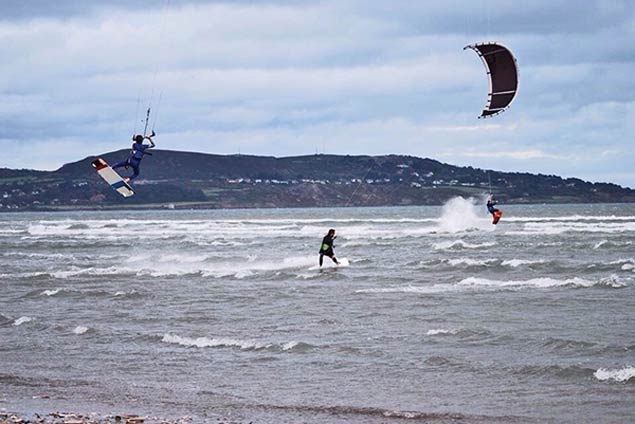 Kitesurfing in Dublin Bay. It may not be sailing as most of us know or expect it, but it’s the form of sailing which is most compliant with Social Distancing and other Covid19 requirements
Kitesurfing in Dublin Bay. It may not be sailing as most of us know or expect it, but it’s the form of sailing which is most compliant with Social Distancing and other Covid19 requirements
Moving on up the size scale, the next least infective sailing sport is surely for someone who has his or her own driving licence and a tow vehicle and a versatile trailer for something solo-sailed like a Laser or the significantly lighter RS Aero, ideally with a beach to launch from, for at all times it’s the avoidance of sociability-encouraging shoreside infrastructure which is the key.
But if we move into any boat size above that, the anti-infection problems rise exponentially, and we’re very quickly into areas where intense shoreside socializing is an integral part of the complete sailing/regatta experience. Yet although the cancellation of the Glandore Classics in mid-July was something we could take in our stride, as it was in a sense linked to the already-cancelled RCYC Tricentenary Cork Week, the cancellation of Cruinniu na mBad in Kinvara, scheduled for the 14th to 16th August, was something of a wake-up call (and a shock) when it came at precisely 11.19 on Wednesday morning.
 Dr Mick Brogan (left) with his Arctic voyaging shipmate Jarlath Cunnane at the Ilen Reception at the Royal Irish YC a year ago. It was with heavy hearts that Dr Brogan and his Committee decided this week that Cruinniu na mBad 2020 in Kinvara in August had to be cancelled. Photo: W M Nixon
Dr Mick Brogan (left) with his Arctic voyaging shipmate Jarlath Cunnane at the Ilen Reception at the Royal Irish YC a year ago. It was with heavy hearts that Dr Brogan and his Committee decided this week that Cruinniu na mBad 2020 in Kinvara in August had to be cancelled. Photo: W M Nixon
For mid-August is all of three months away, and with the current hopeful progress in handling the pandemic, we couldn’t help but hope that Kinvara might be a real possibility. But the Kinvara chairman Dr Mick Brogan is a Connacht GP in addition to his many traditional boat regatta and voyaging credentials, he brought his medical knowledge to his Committee’s acute awareness of just how un-self-consciously and totally sociable the Kinvara gathering is, and they regretfully but decisively pulled down the shutters.
In fact, Kinvara during Crunnui na mBad is sociability on a scale which well matches the apres-ski scene in the Alpine village of Ischgi in the Austrian Tyrol, which was notoriously one of the earliest hotbeds of Covid-19 infection in Europe, and it would be tempting fate and rejecting the science to think that even three months hence, Cruinnui na mBad could safely be staged.
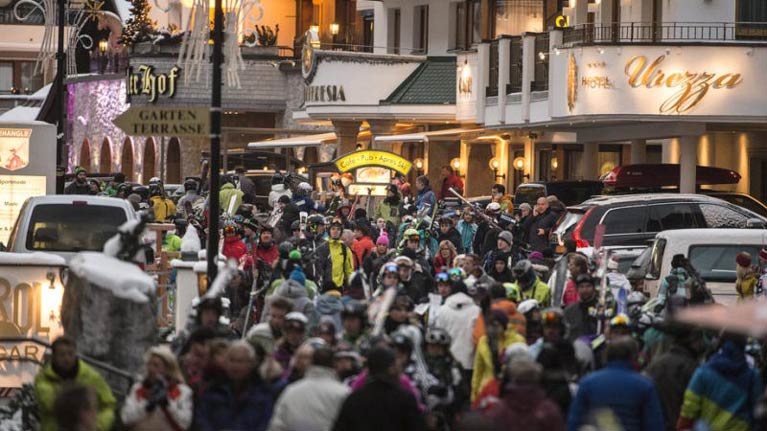 Hotbed of infection – the après ski scene at Ischgi in Austria
Hotbed of infection – the après ski scene at Ischgi in Austria
 Where social distancing is impossible – aboard Mick Brogan’s traditional ketch Mac Duach at Cruinniu na mBad at Kinvara
Where social distancing is impossible – aboard Mick Brogan’s traditional ketch Mac Duach at Cruinniu na mBad at Kinvara
But not all sailing events are so closely inter-woven with a massive social gathering ashore, and while it’s a bit rough on established yacht club hospitality facilities to suggest such a thing, in the extremity of our current situation, with enthusiastic sailors mad keen to get afloat, it should be possible to devise sailing events involving little or no shoreside infrastructure at all.
We discussed some aspects of this four weeks ago in outlining Peter Ryan of ISORA’s thinking about the possible staging of the Dublin Bay to Cork Harbour Race as early as 31st July, and it’s a theme which can usefully be developed if the authorities don’t completely put the kibosh on such ideas.
For the heart of it all is ISORA’s offshore nature. It could be argued that its HQ is a waypoint midway between Dublin Bay and Anglesey. Thus all its activities can be totally offshored and certified disease-free. Its members’ boats would only be eligible to race if they can produce an electronically-verified medical certificate showing that all their crews are virus-free as they assemble aboard to race. Thus they will in effect become a healthy family bubble going sailing.
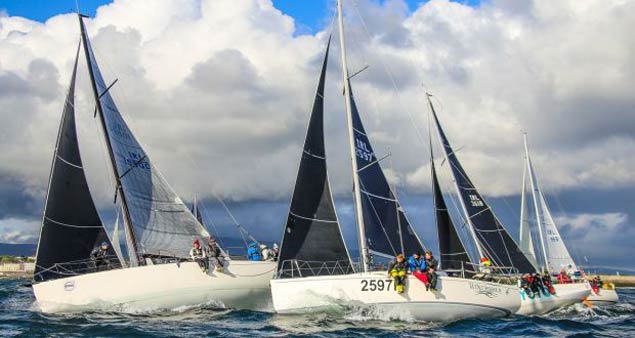 The ISORA fleet getting away for an offshore race which started outside Dun Laoghaire Harbour. Provided each crewmember is certified free of Covid-19, ISORA could provide racing without any direct reliance on shoreside infrastructure or facilities. Photo Afloat.ie/David O’Brien
The ISORA fleet getting away for an offshore race which started outside Dun Laoghaire Harbour. Provided each crewmember is certified free of Covid-19, ISORA could provide racing without any direct reliance on shoreside infrastructure or facilities. Photo Afloat.ie/David O’Brien
As for all the administration of the racing, it can be done with a fast and seaworthy committee boat (something like John Brennan’s new Redbay Stormforce 1650 as recently revealed on Afloat.ie would be ideal) complete with virus-free crew. The speed and seaworthiness are important as both the start point and the finish as monitored by this one boat have to be kept as flexible concepts, and while the use of a shore point for the other end of the start and finish lines is preferable to give the people on land some sense of identifying with the race, it’s not essential, and the South Burford Buoy in Dublin Bay and the Daunt Buoy off Cork Harbour could serve equally well.
It’s appreciated that with such a setup, the temptation to simply keep the fleet in the Irish Sea and make up the miles with a course taking in the Isle of Man or other in-place fixed marks would be considerable. But we have to remember we’re talking 24-carat gold sailing history here with the 160th anniversary commemoration of the totally-pioneering Dublin Bay to Cork Harbour Race of 1860, so a bit of respect for some tradition is very much in order.
Meanwhile, there’s nothing more exasperating than people insisting that they have to have a clearcut and transparent plan with definite figures and real dates so that they can “confirm the arrangements of their own personal programme”.
You would think that we’re facing into a busy summer with a hectic choice of May Balls, June Regattas, and July Gala Events. But the fact is, folks, we’re facing into a desert. Thus ingenious sailing ways of getting around this are now top of the agenda, but they’re not going to happen any time soon. And with scant rainfall since February, it may become a desert in more ways then we’d like.
 With some really imaginative thinking and compliance with restrictions, we may be able to ensure that this is not the memory we carry forward from the Irish sailing season of 2020.
With some really imaginative thinking and compliance with restrictions, we may be able to ensure that this is not the memory we carry forward from the Irish sailing season of 2020.
While many glassfibre boats may have been kept happily afloat through the winter in their marina berths, most wooden traditional and classic craft have been lifted ashore. Even where they are stored under good covers, the recent prolonged periods of bright sunlight, extreme afternoon heat, and exceptional night-time cold have been very bad indeed for their old timbers. Ideally, they should be afloat as soon as possible. But if that isn’t permitted until some time in June, then relief can be provided with regular gentle hosing.
Yet already we’re being warned of imminent water shortages, and it’s only mid-May. The use of hosepipes might soon be severely curtailed. Could it be that - to add to all our woes - we’re going to finally have to accept that, for many years, we have been managing our island’s unrivalled availability of perfect freshwater with the same expertise that the Venezuelans have been showing in the handling of their abundant oil reserves?
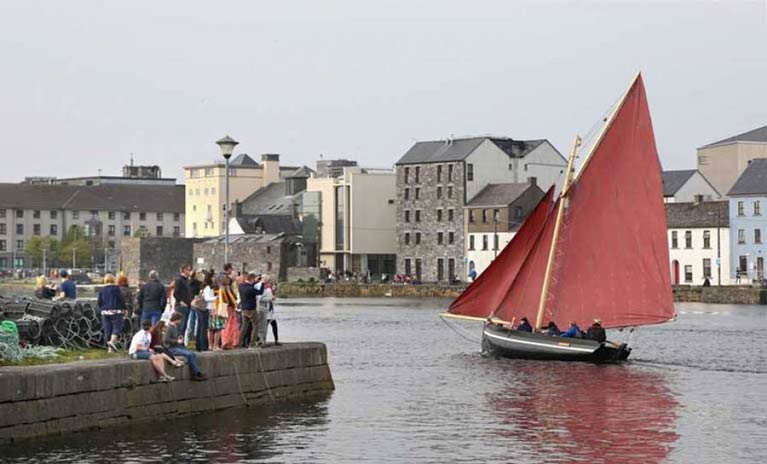 The restored Gleoiteog type Galway Hooker Lovely Anne sailing into the River Corrib off The Claddagh in Galway. The timbers of traditionally-built wooden boats like this are particularly prone to deterioration when ashore in hot weather and intense sunshine. They need to be regularly dampened at the very least, and ideally, they should be afloat
The restored Gleoiteog type Galway Hooker Lovely Anne sailing into the River Corrib off The Claddagh in Galway. The timbers of traditionally-built wooden boats like this are particularly prone to deterioration when ashore in hot weather and intense sunshine. They need to be regularly dampened at the very least, and ideally, they should be afloat
How Can Keelboat Racing Work with Social Distancing?
Olympic helmsman, professional sailor and coach Mark Mansfield takes a look at how it may be possible to return to keelboat racing while maintaining social distance onboard.
The latest Government five-phase programme appears to allow the reinstatement of boating and sailing from May the 18th, under certain restrictions.
The RNLI and Coastguard will likewise need to lift their advisory notice as well for this to happen.
Irish Sailing is liaising with the yacht clubs in Ireland and the Government to get clarity on specific aspects of this five-phase plan. In the interim, commencing racing appears to be positioned in Phase 3, which would begin on June the 29th but many sailors are asking; how can this happen under the requirement to also socially distance ourselves from others?
 Article author Mark Mansfield sailed the Star keelboat for Ireland at four Olympic Regattas between 1996 and 2004. He is a multi-class Irish keelboat champion
Article author Mark Mansfield sailed the Star keelboat for Ireland at four Olympic Regattas between 1996 and 2004. He is a multi-class Irish keelboat champion
Other sports are also in the same situation with resumption to training planning on commencing in Phase 2 in early June and some matches in Phase 3. Team sports like soccer, Gaelic, hockey, basketball and others have further complications in that they compete directly against opposition at close quarters.
Luckily in sailing, though we are a team sport, our opposition usually is quite a bit away from us. It is therefore in our own hands how, on boats, we can keep our distance when racing. The following are my thoughts on how this can happen successfully, keeping our sport going in these difficult times.
Dinghies that rely on rescue boats when capsized, and two-person dinghies and smaller keelboats will have additional challenges. However, for the purposes of this article, I will concentrate on larger keelboats that have engines to allow them to look after themselves in the event of an emergency.
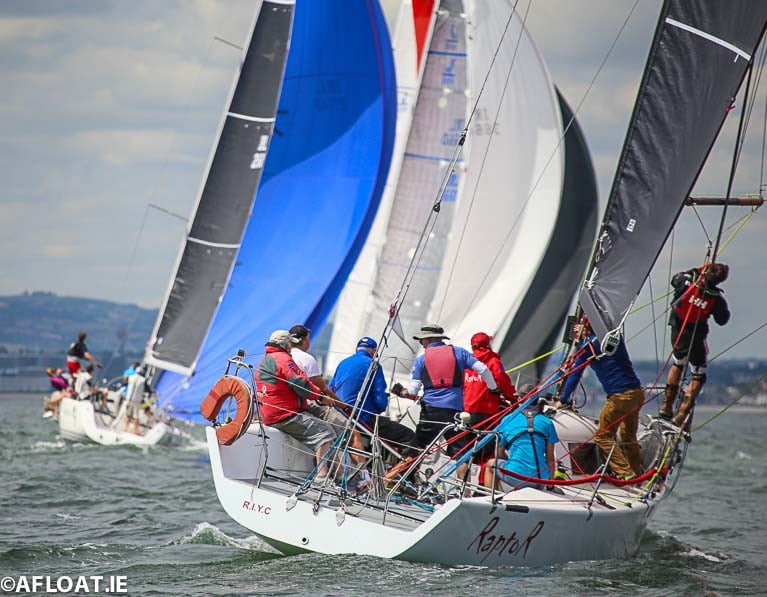 Class One boats approach a leeward mark on Dublin Bay in 2019 Photo: Afloat
Class One boats approach a leeward mark on Dublin Bay in 2019 Photo: Afloat
Fully crewed or shorthanded?
Though there are other options around bubbles, family crew and the like, clearly it will be challenging to sail fully crewed for the first couple of months and still keep the required space between each other. The sight of 8 bodies huddled together on the rail while going upwind on a 35-foot cruiser-racer would not only be regarded as unsafe but irresponsible and would send all the wrong messages.
So, at what crewing levels could racing happen and still keep close to the permitted social distancing levels?
It is possible to specify a max crew level for different sized boats.
Different sized boats have different crewing needs. An SB20 sportsboat, for example, does not need the same crew numbers as a 42-footer. So what crew numbers would be required on different sized boats. Here is my estimate:
- Up to 26 footers 3 max per boat – Only 2 allowed to sit over the side
- Over 26 foot and up to 31 foot – Max of 4 crew – only 2 allowed to sit over the side
- Over 31 foot and up to 36 foot – Max 5 crew – only 2 allowed to sit over the side
- Over 36 foot and up to 41 foot – Max 6 crew – only 3 allowed to sit over the side
- Over 41 foot and up to 46 foot – Max 7 crew and only 4 allowed to sit over the side
And so on in 5-foot sized increases.
An amendment to The Notice of Race (NOR) could be inserted for events to make these reduced numbers a requirement, while we still have these restrictions due to COVID 19.
Is this enough crew to race boats with spinnakers?
In the Fastnet Race in 2019, There were 65 entries in the Two-handed class, ranging from 45 footers, down to 30 footers. Most boats were in the 35-foot size range and used spinnakers. Yes they all would have autopilots, and that effectively gives you an extra pair of hands doing sail changes, but that still would mean that they would have had two less crew than my crew size thoughts above.
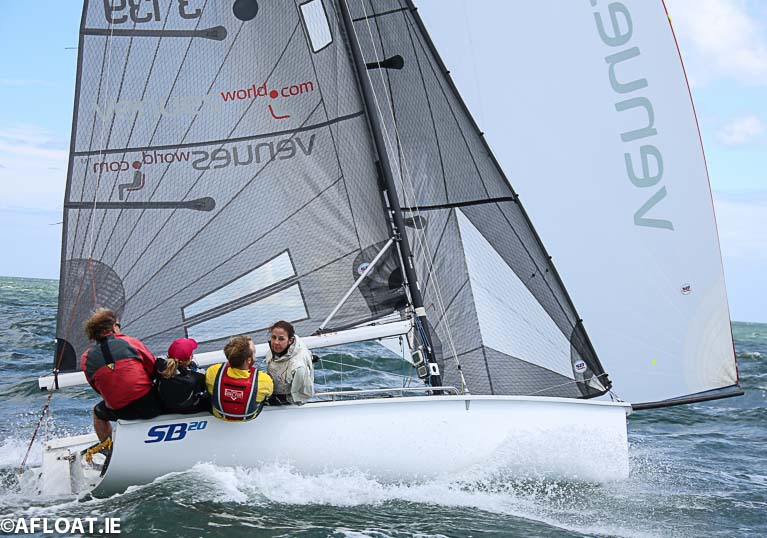 An SB20 racing under spinnaker in strong breeze with a crew of four on Dublin Bay Photo: Afloat
An SB20 racing under spinnaker in strong breeze with a crew of four on Dublin Bay Photo: Afloat
SB20
Certain classes, such as the SB20, would still find it challenging to keep a distance with 3 on board, and having spoken to the class, they could see a possibility, if required, to sail with just 2 crew, particularly in light winds. In stronger winds, they may wish to just sail without spinnakers.
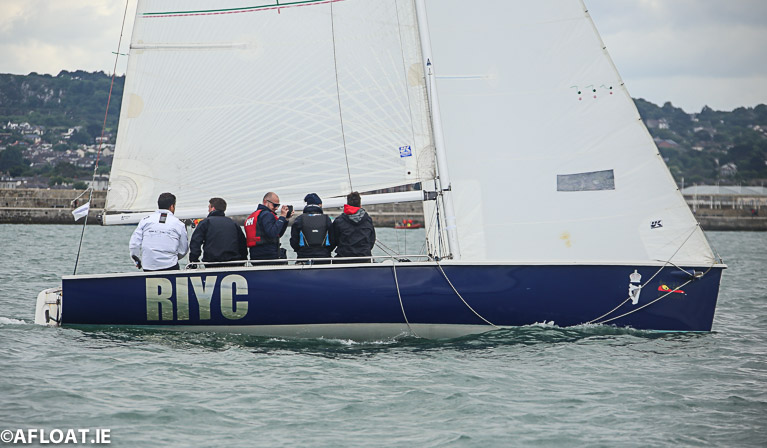 A 1720 keelboat with a crew of five in Dun Laoghaire Harbour Photo: Afloat
A 1720 keelboat with a crew of five in Dun Laoghaire Harbour Photo: Afloat
1720
The 1720 class has also looked at this, and Class Captain Clive O'Shea told Afloat: "If required, the 1720 class is ideally situated to reduce numbers to allow social distancing while racing. Three crew can keep apart, and we still have the option to go with small spinnakers and small jibs, if needed."
So how would this happen on a typical small cruiser, like a J24 or a medium-sized cruiser-racer like a J109?
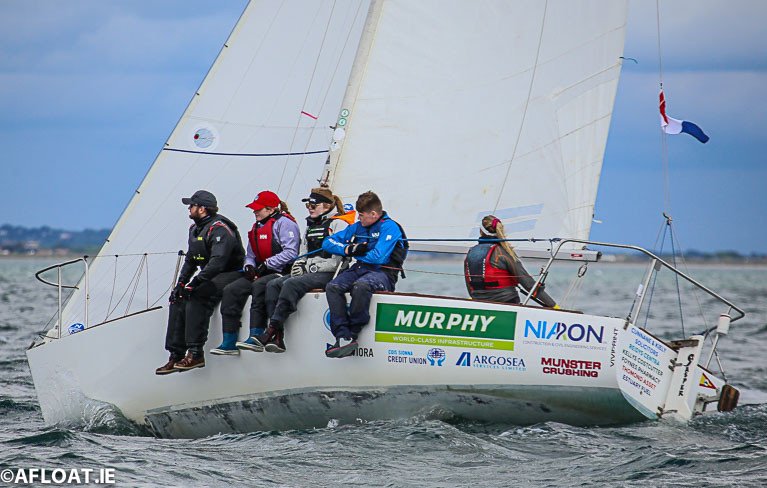 A J24 in racing mode Photo: Afloat
A J24 in racing mode Photo: Afloat
J24
Three crew could handle a J24; One is helming and trimming the main, one in the cockpit, and one on the bow. The Bowman stays forward of the shrouds; the cockpit person stays away from the helm, up by the hatch. It won't be all that easy, but 30-foot boats like Etchells have similar-sized sails and normally sail with 3.
 A fully crewed J109 on Dublin Bay (above) and a two-handed crew on the same model (below)
A fully crewed J109 on Dublin Bay (above) and a two-handed crew on the same model (below)
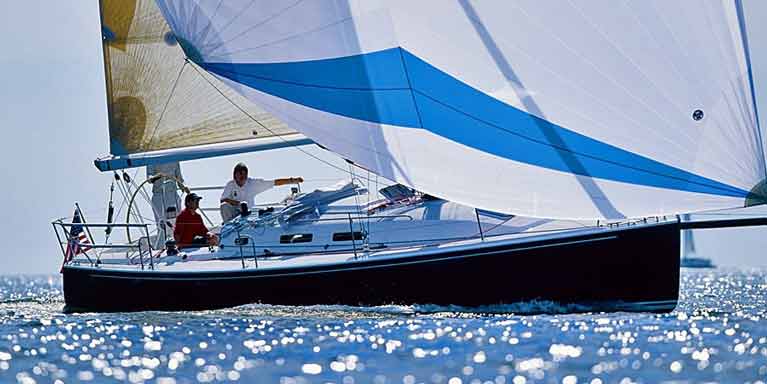
J109
Five on a J109; One on the wheel, staying back a bit. One in the cockpit is trimming the mainsheet but sitting well forward. Helm adjusts the traveller or leaves it in the centre. One sits in the hatch, or on top of the coachroof. The Jib Trimmer sits out, and during tacks, they pull in the new sheet while the Mainsheet Trimmer has let off the old jib sheet. The Bow person sits out forward of the shrouds; jib trimmer sits out to windward, 2 metres back from the Bowman. Downwind more room becomes available as both sides of the boat can accommodate the crew. Andrew Craig, Class Captain of the J109 class in Ireland, says, 'the J109 is well suited to shorthanded racing with the small jib and plenty of space for a reduced number to spread out. The Asymmetrical Spinnaker requires no pole which also makes shorthanded use possible in the right conditions'
White Sails & other options
For those with boats that are harder to sail, or if a crew is not that experienced, there is also the white sails (non-spinnaker) fleet to compete in, until fully crewed racing resumes.
Dublin Bay Sailing Club is the largest yacht racing club in the country with over 250 boats in 20 or so classes. Its Commodore, Johnathon Nicholson has this to add; "Along with the other clubs, DBSC is working with Irish Sailing to create a clear and safe path to get back on the water. We are currently investigating the practicalities of racing short haded with the appropriate physical distancing and when it could be introduced following the guidance provided by the government, Sport Ireland and Irish Sailing".
I appreciate there may be occasions during racing that crew get closer than planned for short periods. This is to be expected, but that will be the situation in virtually all sports that will likely be competing over the next few months. It is incumbent in our sport to come up with a plan to compete as safely as possible. This is just one option, and there will likely be others. Of course, this COVID-19 restriction could be tightened or eased during the next few months, and this proposed plan would then need to be looked at again. Reducing racing crew numbers also decreases the numbers that come back into the clubs allowing easier social distancing ashore.
Ultimately, however, as all sailors know, it is up to each individual skipper and crew to make their own decision about whether to go to sea or not.
Irish Sailing hopes to have 'more information' early this week on its 'Return to Sailing' document, outlining guidelines for a return to the water as Government COVID-19 guidelines are eased.
In his latest update, dated May 8th, Irish Sailing Chief Executive Harry Hermon now says the government body Sport Ireland has indicated they believe 'sailing will be able to resume in Phase 1 (May 18), subject to the approval of the Irish Sailing plan and the lifting of the Coastguard's current advisory notice'.
So far, the plan has not been published but, as Afloat previously reported, the national governing body has prepared a 'draft document' that it circulated to clubs and classes. It says it is 'a first look' at recommendations for how sailing, windsurfing and powerboating activities may be resumed on a phased basis.
Shore Angling returned at the weekend across the country but boat anglers are subject to Coastguard safety guidelines, which currently recommend avoiding the water for any recreational activities.
The May sunshine, however, brought numerous small craft out at the country's biggest boating centre, Dublin Bay on Saturday. On the water were stand up paddleboards, kayakers and speedboats and a variety of RIBs despite the Coastguard's renewed pleas for recreational users not to go afloat.
Dun Laoghaire Marina, the base for over 500 pleasure craft, has indicated there will be full access to boatowners by May 18th in line with government guidelines.



























